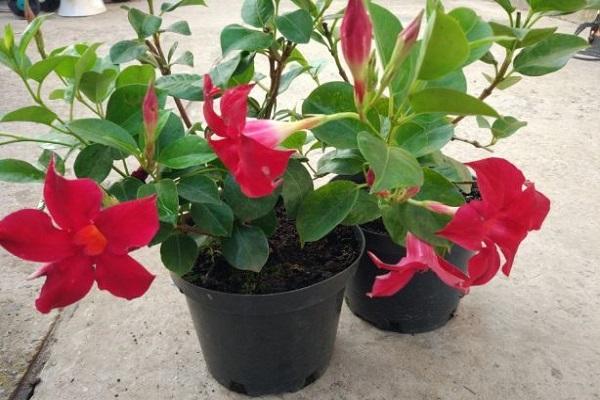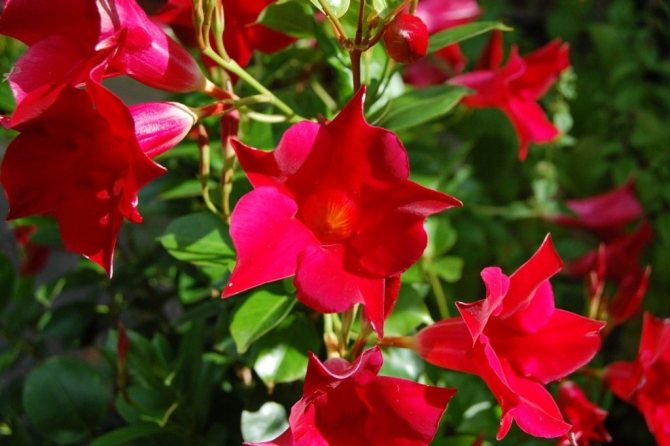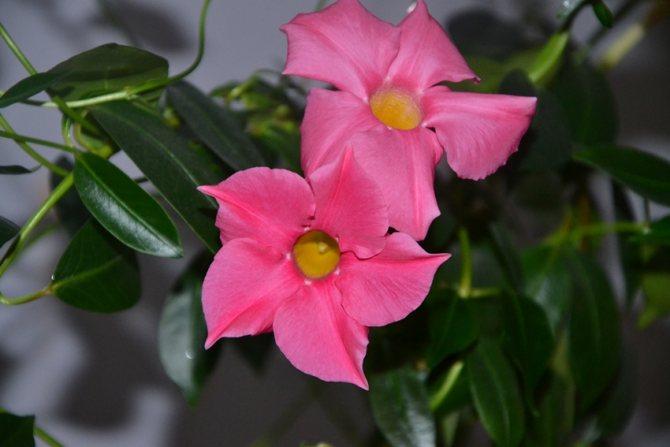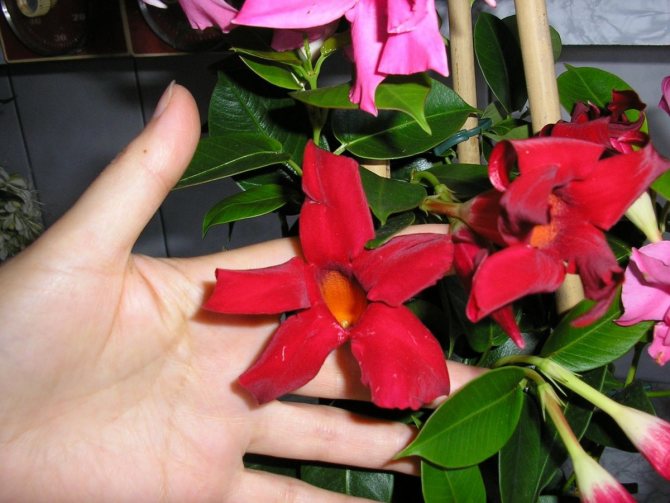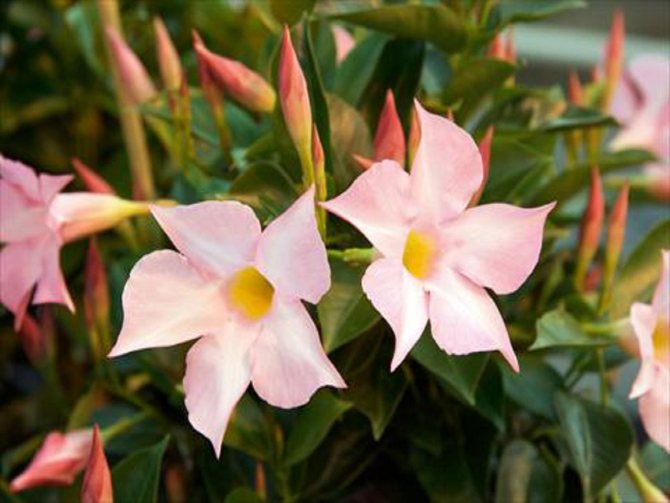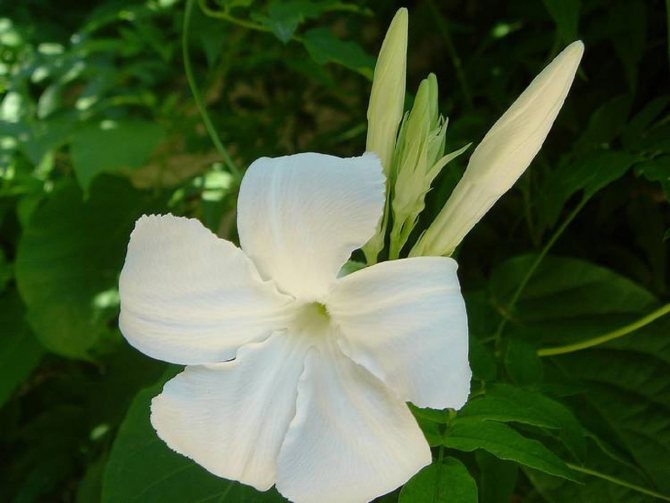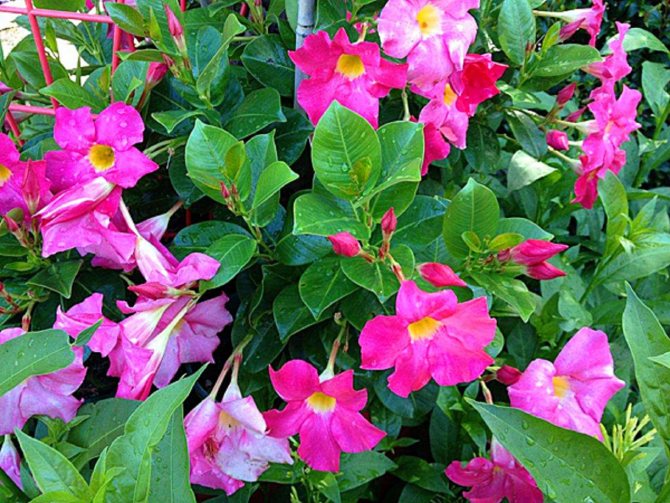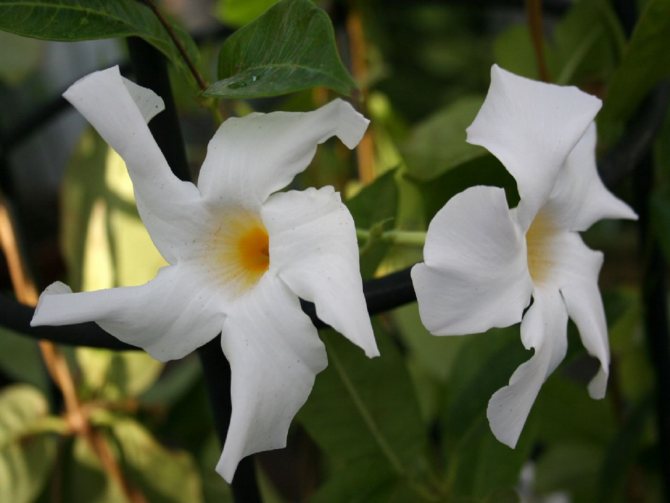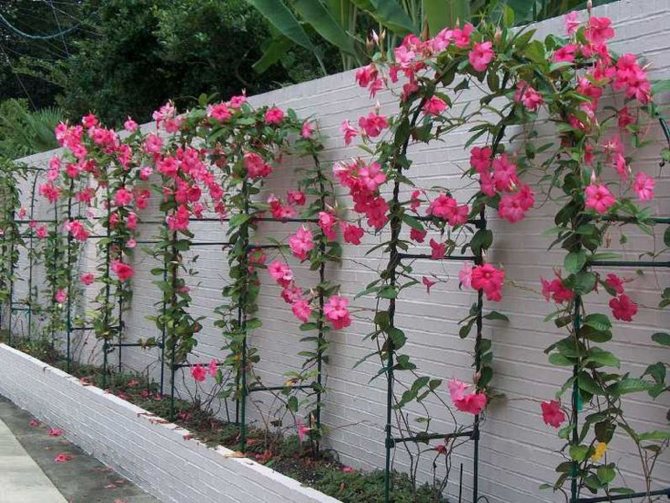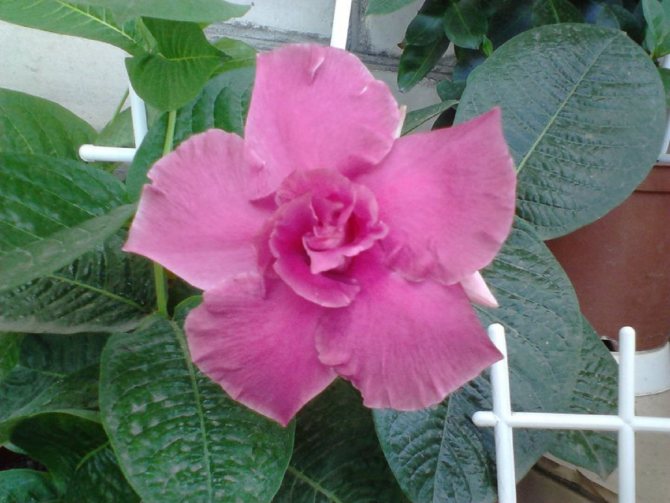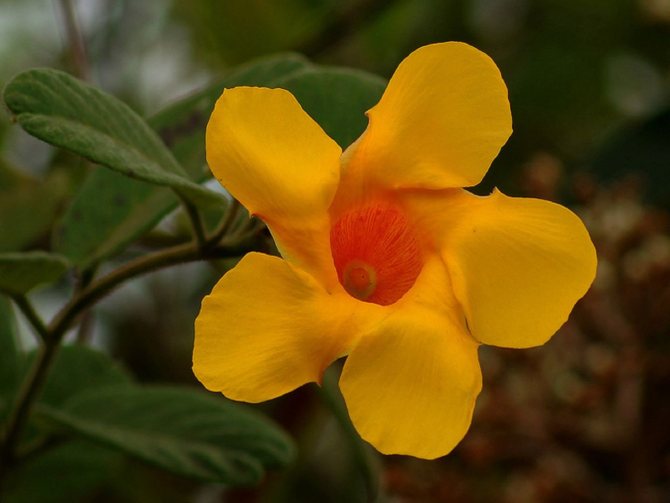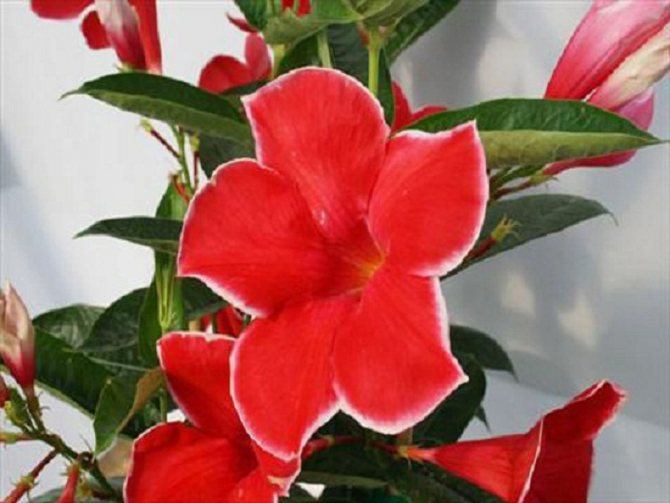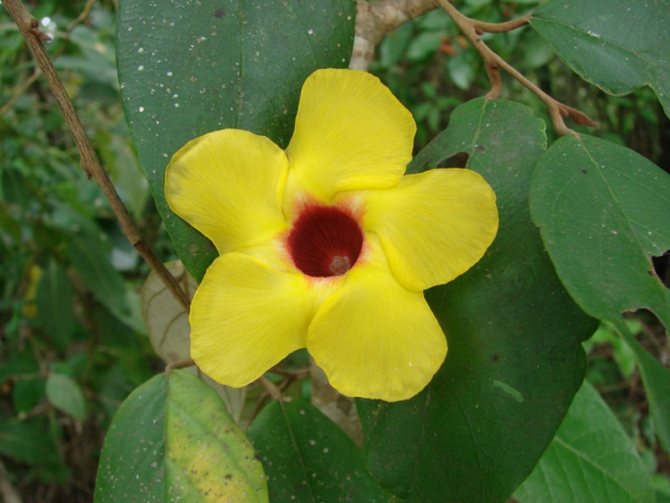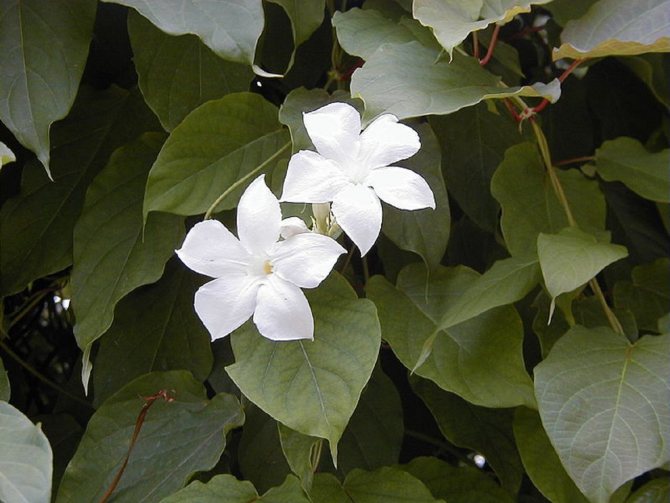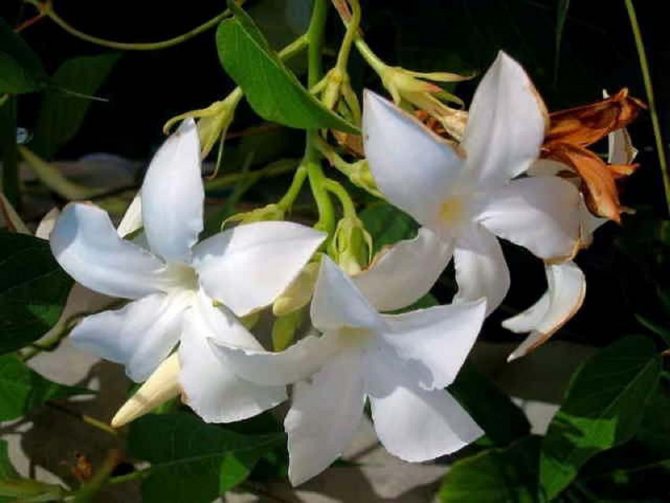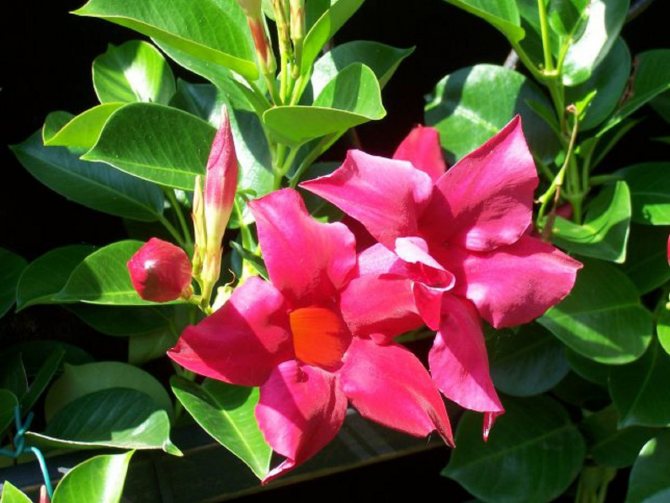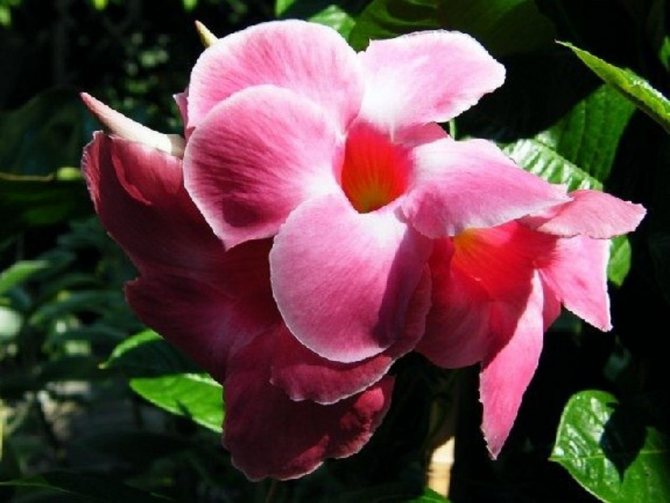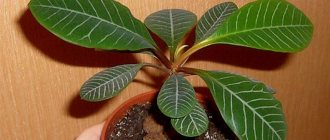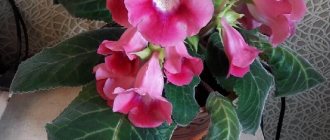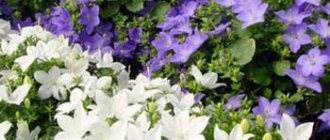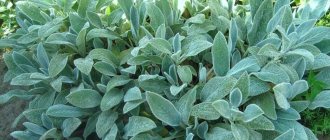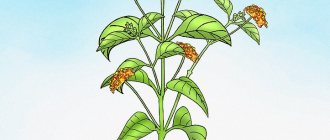Dipladenia (Dipladenia) is a climbing perennial plant of the kutrov family. These are evergreen vines with smooth rich green leaves and inflorescences of tubular flowers 10 cm in diameter. On one liana-shaped specimen, up to 50 inflorescences with a pleasant aroma can bloom at the same time.
The homeland of the diplomatic family is South America, Argentina. The flower can reach a size of 5 meters, but with proper pruning, it can be successfully grown indoors with a maximum length of half a meter. Dipladenia is a perennial flower with a high growth rate. For a year, the plant adds 60-70 cm in length.
See also how to grow indoor allamanda and catharanthus.
| Growth rate is high. For a year, the plant adds 60-70 cm in length. |
| Blooms in summer with proper care. |
| The plant is difficult to grow. |
| It is a perennial plant. |
Description
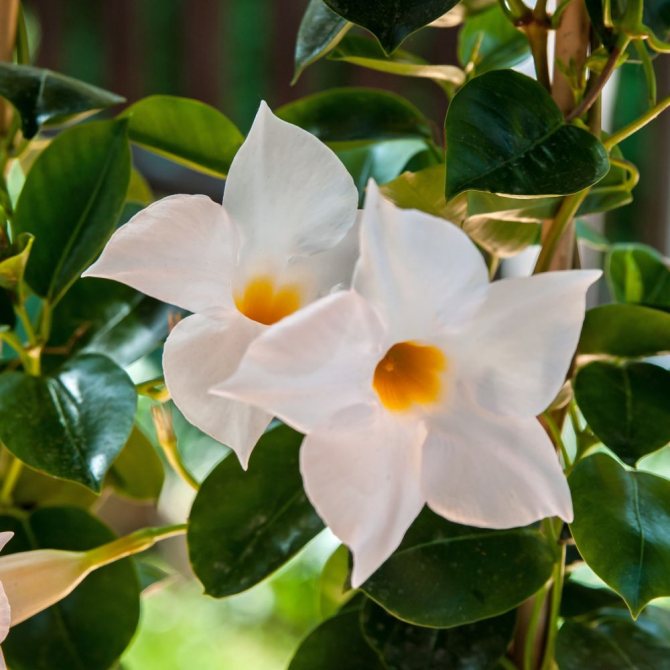
The diplomatic family, the photo of which you will find in the article, belongs to the Kutrov family. In its natural environment, this vine can be found in the tropical and subtropical forests of North and South America. The genus of diploses includes 180 species of annuals and perennials, and there are countless varieties. But the following varieties are especially popular with flower growers:
- bright yellow Allamanda;
- snow-white Summer Snow;
- cherry red hood;
- golden yellow;
- blood red Scarlett Pimpernell.
Dipladenia, aka Mandeville, is a fast-growing, evergreen and flowering vine. It has curly woody stems covered with leathery leaves with a glossy surface. When the plates break, poisonous milky juice is released. Therefore, wear gloves when nursing and breeding dipladenia.
Funnel-shaped, five-petalled fragrant buds give particular attractiveness. They densely cover the stems of the vines, and up to 80 inflorescences open simultaneously on one plant. The petals are colored red, crimson, lilac, pink and white.
Botanical description
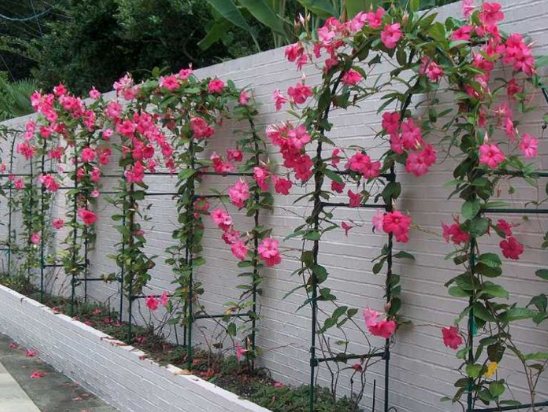

The plant can be an excellent decoration for a summer cottage.
Translated from Latin means "possessing double nectaries." In the modern classification, the plant is called Mandeville. Grows in the form of shrubs, trees and vines.
The structure, height, as well as the shape of the culture depends on the surrounding conditions. The plant naturally forms a vine. If you prune the buds after flowering, over time, the diplopia will transform into a bush.
Funnel-shaped flowers are of particular value. Their average size is 12 cm. They can retain their decorative effect for more than two weeks. The petals are red, pink and white. The middle is colored yellow.
Breeders continue to experiment with existing plant varieties. Several new ornamental crops have been developed. Consider the most popular examples of diploma:
- Sandera. Reaches about 3 meters in length. Forms oval or pointed leaves with a leathery surface. Flowers are pink.
- Lovely diploma. The length exceeds 2.5 m. Large, dark pink flowers open on the stems.
- Shiny. It is valued for its glossy oval-shaped leaves. The average length is 4 meters. Produces pink flowers.
- Bolivian. This type of diploma can decorate any interior. The length is about 4 meters.Bright white inflorescences bloom.
- Chilean Jasmine has egg-shaped leaves. Attached to a massive shoot. Its height is on average 7 meters. Produces white and milky fragrant flowers.
Cultivating a Diploma at Home


Diplomas are a rather capricious plant. And in order to achieve long flowering and numerous buds from it, it will be necessary to create comfortable conditions for the culture. The following agrotechnical measures will help in this:
- regular watering;
- periodic feeding;
- support installation;
- transfer;
- pruning;
- prevention of diseases and pests.
In addition, it is important to maintain optimal lighting and temperature around diplodenia. How to care for a vine, you will learn in more detail in the next part of the article.
What if Tropical Diplomacy Sheds Leaves?
Whiteflies can lead to the fact that diplodesia not only sheds leaves, but also dies. It is the improper care of a houseplant that becomes the main reason for the appearance of these insects - we are talking about a dry climate and a lack of spraying.
It is easy to recognize these pests: brown spots appear on the Mandeville.
To know what means to use to destroy such parasites, you need to assess the degree of damage to the plant. If the situation is not very bad, rubbing with a cotton pad soaked in acidic water will suffice. You can also add some regular soap to this liquid. But if the threat of death is great, you should immediately use such a drug as Fitoverm.
The unsuitable conditions that gardeners create at home also become the cause of many diseases of the tropical vine. In addition, a violation of the peculiarities of caring for it also affects the existence of a given plant outside the zone of its usual growth.
Diseases of diploidia can manifest themselves in a number of negative phenomena. First of all, the plant can begin to dry out and its leaves curl if it lacks moisture in the air and the soil itself. Direct influence of sunlight can also contribute to this.
Moreover, excessively dry air will cause the Mandeville to begin to drop its leaves, and its inflorescences will fall off.
In addition, if the vine began to suddenly fall of leaves, and it began to dry out itself, you should pay attention to the abundance of its watering (the gardener could simply fill the soil) and the temperature of the content in winter (the Mandeville should not freeze).
Please note that a violation of the temperature regime at one time or another of the year also affects why leaves fall off in room diploidia and inflorescences do not appear. That is why you need to make sure that in summer the room is no more than + 25 ° C, and in winter, make sure that the vine does not freeze - that is, it should be at least + 10 ° C in the room.
Temperature
Dipladenia is a tropical flower, which means it is thermophilic. In summer, keep the room at + 22 ... + 26 ° C. But if the thermometer rises above this mark, the culture will not die. On the contrary, the color of its buds will become richer and brighter. In winter, diplodenia begins a period of rest. And at this time, it is advisable for the liana to drop to + 15 ... + 16 ° C.
The plant needs fresh air at any time of the year. Therefore, ventilate the room regularly. But protect the vine from drafts - it categorically cannot stand them. In the summer, take the pot out to the balcony or garden. But install the flower in a quiet place away from gusts of wind, drafts and direct sunlight.
The classic problems of growing vines
The plant reacts sharply to improper care. It can completely lose its decorative effect. Monitor your diplomatic status regularly. In hot summer conditions, the leaves of the creeper turn yellow and fall off.The same symptoms in winter are caused by a sharp drop in temperature and waterloggedness of the substrate.
In a dimly lit room, leaves and stems fade. The number of inflorescences will sharply decrease. Dry air causes flowers to fall off. We need to act immediately. Spray the plant with water. Place a pot of liquid next to the flowerpot. A humidifier will also do an excellent job with the problem.
The slowed down development of the vine is associated with the poor composition of the soil. In such a substrate, the likelihood of a lush bloom is practically zero.
A tropical plant can also be affected by several pests. Specimens that were on the balcony or plot in the summer are especially susceptible to the settlement of insects. Liana can be damaged by aphids, mealybugs, spider mites, scale insects. Inspect the plant carefully before moving it into the room. The parasites tend to settle primarily on the lower parts of the leaves. As a preventive measure, wash the plant with warm water. Isolate the flower from other indoor crops for the first fortnight.
Liana will react to any violations of the rules for leaving with external changes. Examine your diploma regularly. Follow the basic rules for growing. This way you can avoid unpleasant surprises. A tropical guest will decorate any room in your apartment.
Lighting
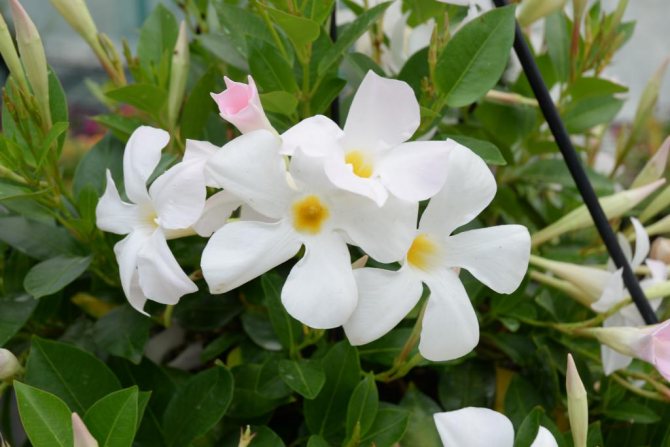

Indoor diploidia is a photophilous flower; in low light, it will not work to get numerous buds from a plant. But direct sunlight is contraindicated in vines. Therefore, place the pot near an east or west window. As a last resort, grow a flower on a southern windowsill. But at noon, shade the plant from direct sunlight. To do this, hang tulle or gauze over the crop, otherwise the foliage will get burned.
The reasons why the leaves of diplodenia dry up, turn yellow and fall off
The vital activity of the already mentioned spider mites is also capable of influencing the fact that the diplodenia gradually turns yellow, and its leaves fall off. Another signal of this can be red spots and the presence of a plaque in the form of a cobweb on different parts of the flower.
Another pest can reach Mandeville - a mealy wormthat feeds on plant juices. It appears then if bad water is used when caring for a flower, there is a low temperature in the room, the liana does not have enough sunlight, or dirt accumulates on its leaves. It is this parasite that can influence the drying up and withering of the diploidia.
A signal that it is time to start fighting this pest will be the sluggish leaves of the indoor specimen and its deformed buds. In addition, small mosquitoes can be seen near the container with the plant, and white larvae on the stems of the Mandeville itself.
To cope with such an unpleasant phenomenon, which may be the reason why the leaves of home dipladenia turn yellow, it is necessary to use garlic tincture. It can be done as follows: one head of garlic is scrolled through a meat grinder, and then filled with a glass of hot water (preferably boiling water).
Within 4 hours, the agent is infused, cooled, and only after that it is used to combat the mealy worm: all affected parts of the plant are thoroughly washed. In addition, experts consider "Applaud" and "Phosphamide" to be effective means.
Experienced craftsmen say that in order not to wonder why the leaves of room diplodenia turn yellow and fall off and it stops growing, it is necessary to carry out prevention on time:
- Constantly inspect the plant for insects.
- Repot the Mandeville every year and remember to weed.
- It is imperative to remove all old and dying parts, which in most cases are the cause of pests.
- Do not be lazy and process new containers for creepers with boiling water.
Watering
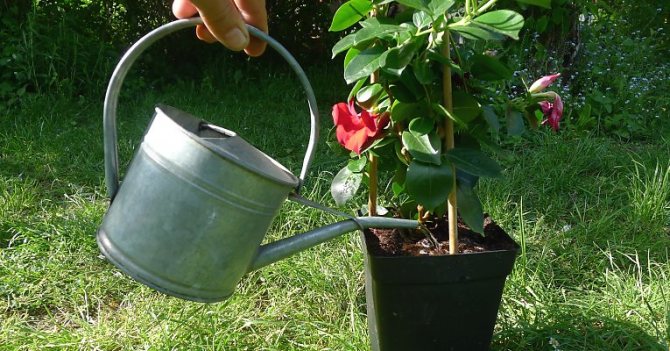

Liana belongs to moisture-loving crops, but it does not tolerate moisture stagnation at the roots. Therefore, approach the watering of diplomacy with all seriousness. Moisten the flower when the substrate dries to a depth of 1-1.5 cm. Usually this happens 2-3 times a week. But in the summer, in the heat, the soil dries up faster. Therefore, the liana needs almost daily watering.
In late autumn, when the plant has a dormant period, reduce watering. And moisten the substrate 2-3 days after it dries completely. In the spring, as soon as the plant begins to wake up, gradually increase the irrigation.
For watering diplodenia, use melt or rain water. If this is not possible, then use regular tap water. But before watering, be sure to filter the water and stand for 2-3 days. Otherwise, the plant will wither from the excess lime present in such a liquid.
Moisten the vine with sour water once a month. To do this, dilute fresh lemon juice in the watering liquid (3-4 drops per liter). You can also use vinegar. But moisten the soil after the "sour" smell of the liquid disappears.
Home care for diploma. In detail
Flowering diplopia
Homemade Diplomacy is also known as Bolivian Rose, Brazilian Balsam or Chilean Jasmine. Its flowering begins in early spring and lasts until the first frost. The flowers of diplodenia are rather large, about 10 cm in diameter, have a pleasant aroma and varied colors.
As a rule, these are inflorescences of raspberry, yellow, pink or cream shades. After blooming, the flowers retain their appearance for 10 days. This plant is ideal for growing on loggias, balconies, verandas, garden plots and is beautiful not only as a flowering bush, but also as a beautifully winding liana.
Temperature regime
Since diplodesia is a tropical plant, a flower needs a warm, humid climate with a temperature of 21-25 ºС during the active growth phase. Also, the liana easily survives hot weather, provided that a high level of humidity is maintained in its habitat. In winter, diplomats arrange a period of rest, which can take place both at a temperature of +5 ºC and at + 15ºC.
Spraying
Dipladenia at home perfectly perceives humidified air, frequent spraying. In a too dry environment, the flower is additionally placed in a tray with pebbles or sphagnum, kept moist.
Directly the plant itself is sprayed with soft water, avoiding contact with the buds.
Lighting
"Bolivian rose" is one of those rare exotic plants that can actively grow in hot sunlight and in a little shade. South, southeast and east windows are perfect for her. In cloudy, cold weather, it is recommended to organize regular additional lighting for many hours.
Watering the Diploma
The plant of diplopia at home does not tolerate overflow, but in the summer it needs frequent watering with soft water. It is carried out as soon as the top layer of the earth becomes dry. For this purpose, rainwater, softened filtered or distilled water is used, since the plant is very sensitive to the quality of moisture.
In winter, during a period of slowing growth, especially when stored at low temperatures, the flower is rarely watered, since the diploidia is able to stay with a dried earthy lump for a long time without prejudice to subsequent development.
Pot for diploma
When choosing a flowerpot for a diplodemy flower, preference is given to wide, but not too voluminous containers. The developed root system of diplodenia does not tolerate the constant moisture of the roots, which is always formed if the plant is placed in a large deep pot "for growth".
When transplanting, vines are guided by the size of its rhizome, picking up a flowerpot 3 cm wider than the previous one.
Priming
The soil for diploma must be acidic and nutritious. A universal azalea soil is suitable, as well as a mixture of the following composition:
- garden soil (2 parts);
- sheet land (1 part);
- peat soil (part 1);
- small pebbles or perlite (1 part).
It is important to remember that a loose soil with a predominance of peat is preferable to a young flower. Sod land is mainly used for mature plants.
Top dressing and fertilization
Fertilize the flower twice a month liquid complexes for beautiful blooming. The dressing used for azaleas is also beneficial. In the summer, you can use it a little more often, once every 10 days. In winter, the plant does not need mineral replenishment.
Transfer
Diplomatic transplantation is carried out every year in early spring or at the end of April. Perennial, abundantly flowering plants are gently transferred into a larger pot or simply replace the top 4 cm of soil. Young flowers, due to their rapid growth, require transplanting two to three times a year.
In both cases, it is important to ensure high-quality drainage of the soil, to pick up flowerpots with good holes for draining excess water.
Pruning a Diploma
As a rule, plant pruning is carried out in early spring at the same time as replanting. At this moment, it is most convenient to correctly form the growth of the plant, to ensure abundant flowering. Highlights of pruning a diploma:
- The "mustache" of a flower is formed if it is more often in a shaded place. If available, such shoots must be cut to compact internodes;
- flower buds appear only on young branches, therefore pruning should be regular;
- pruning is not recommended during the flowering period;
- you can remove old branches after flowering, before the entry of the flower into a dormant period.
Dipladenia is not recommended for ampelous cultivation. The most favorable option is to grow a flower near a wall, stand, ladder or other suitable object that will serve as a support for the vine. When growing a bush-like diplodemy, frequent pruning and a guiding frame are also required.
Dormant period
Home care for diplodenia includes a periodic resting phase of the plant. Most often, this time falls in January, February and early March. For this purpose, the flower is removed to a cool, but well-lit room with a temperature of 5 to 15 ºС. Watering is reduced to a minimum. In this case, the rule works - it is better to underfill, that is, it is more desirable to allow the soil to dry out slightly than excess moisture. Dipladenia does not tolerate constant dampness of the roots; rotting may begin.
Air humidity
To ensure proper care for the diploidia, it is important to maintain high air humidity near the flower. To improve this figure, place the pot on a pallet with damp pebbles, expanded clay or moss. But make sure that the water does not reach the container. Otherwise, the roots of the vine will "suffocate".
Spray the foliage of the crop daily with warm water. This procedure is especially important during bud formation and flowering of the plant. To reduce the maintenance of the crop, buy and install a special device near the pot - a humidifier.
Diploma flower - benefit
When caring for Mandeville, it is important to remember that its juice has the appearance of white milk, a pungent odor and is poisonous (in all parts of the plant). It is necessary to work with the vine using protective equipment - gloves. This culture is used with care in the home where there are small children and animals. But the diplodenia vine has a good effect on the microclimate of the apartment - it heals it.
The plant assimilates carbon dioxide accumulated in the air and emits oxygen, absorbs harmful and toxic substances, microbes and dust. The invigorating aroma emanating from indoor flowers of diplodenia improves a person's well-being, increases the activity of the body, its defenses.It improves brain activity and has a beneficial effect on the respiratory system.
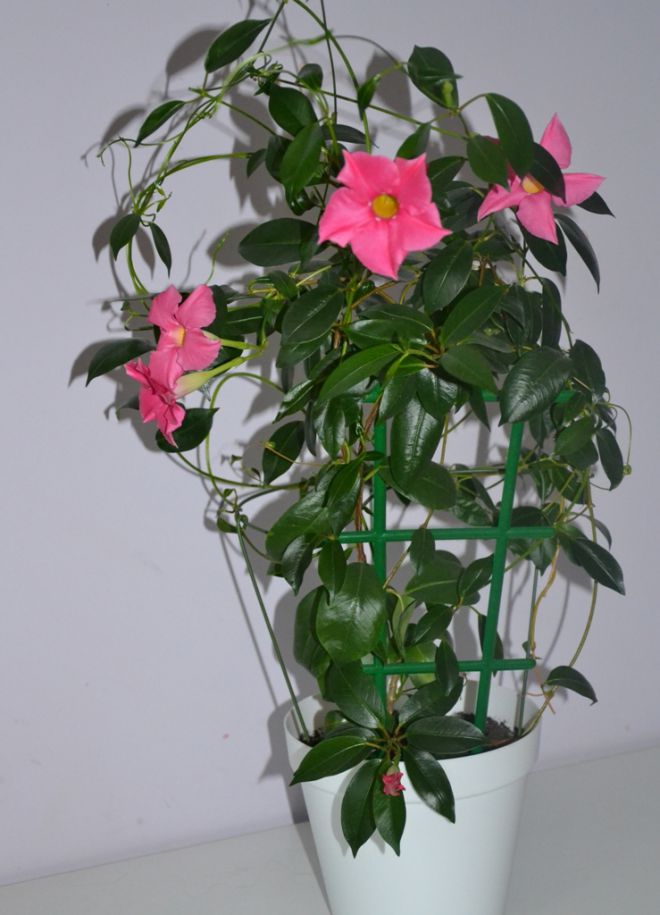

Top dressing
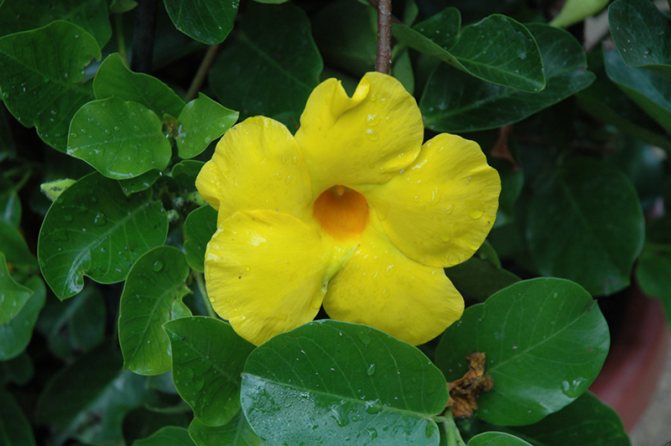

Liana spends a lot of energy on the formation of leaves and buds. Therefore, it is important to maintain the plant and fertilize the soil regularly. Feed the flower from early March to late August once a week with liquid mineral formulations.
Use nitrogen fertilizers in the spring. Then the vine will grow leathery leaves faster. But as soon as the plant begins to form buds, switch to potassium-phosphorus fertilizing. From the beginning of autumn until the end of winter, stop fertilizing.
Types of home diploma with photos and names
This flower includes over 40 varieties of liana-like shrubs. Among them, the most famous are plants such as:
Diplomatic property brilliant
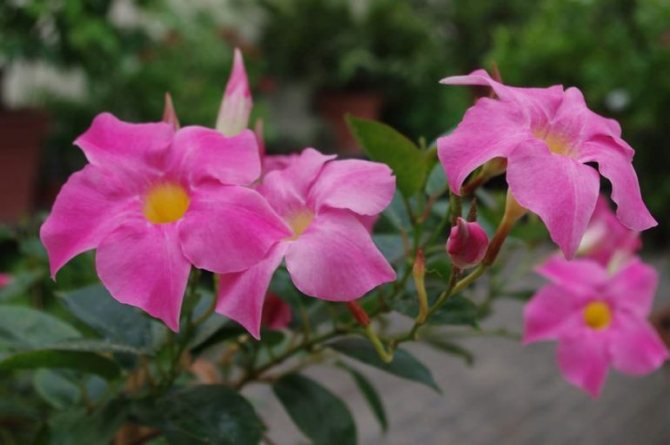

Blossoms in bright pink inflorescences of 5-6 flowers. With the age of the plant, its stem becomes bare, without foliage.
Dipladenia loose Dipladenia laxa
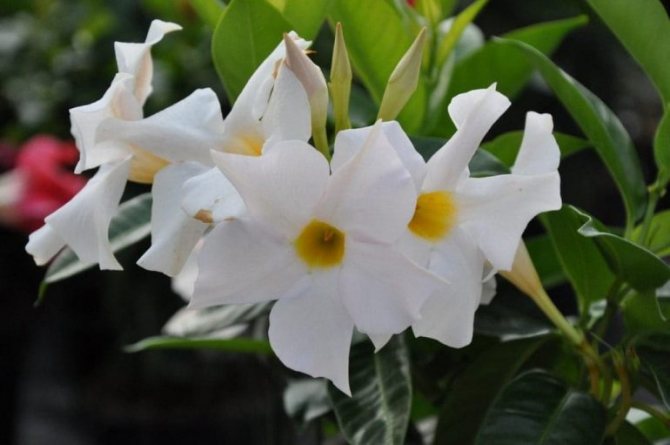

Differs in a powerful stem, profusely flowering white semi-double inflorescences, resistant to low temperatures.
Dipladenia sanderi
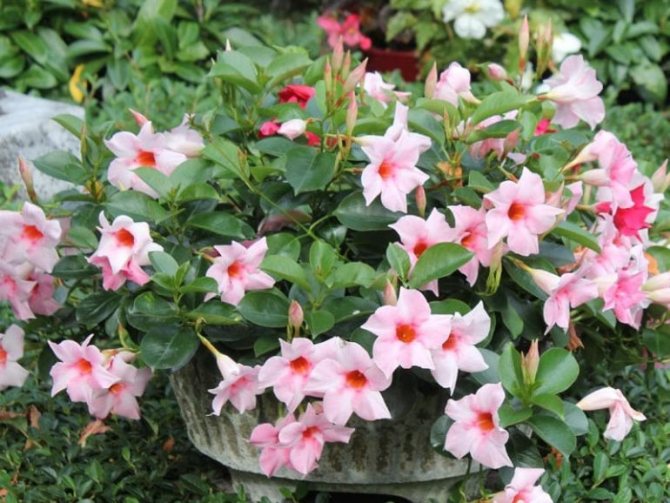

Its main feature is a yellow throat framed by pale pink petals and small rounded leaves 5 cm long.
Large-flowered Dipladenia (Dipladenia x amabilis)
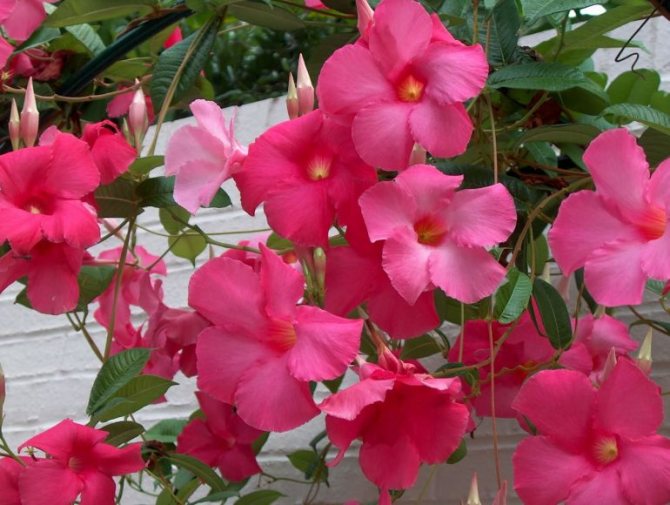

Liana with bell-shaped flowers with a diameter of 8 cm.
Popular varieties of dipladenia, successfully grown not only in greenhouses, but also indoors:
Yellow - a type of liana with golden yellow inflorescences.
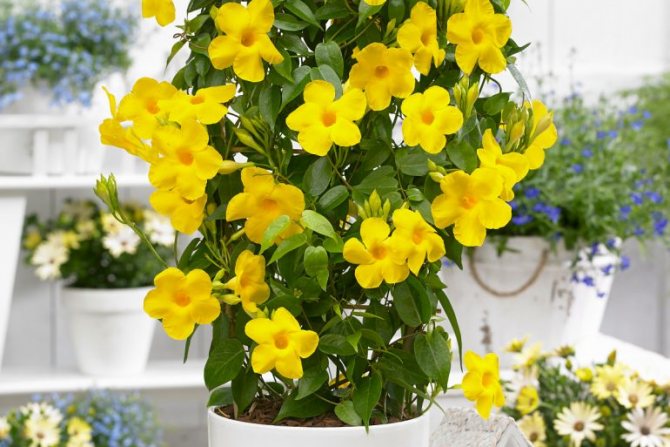

Cream Pink - the species is characterized by pale pink flowers with an orange center.
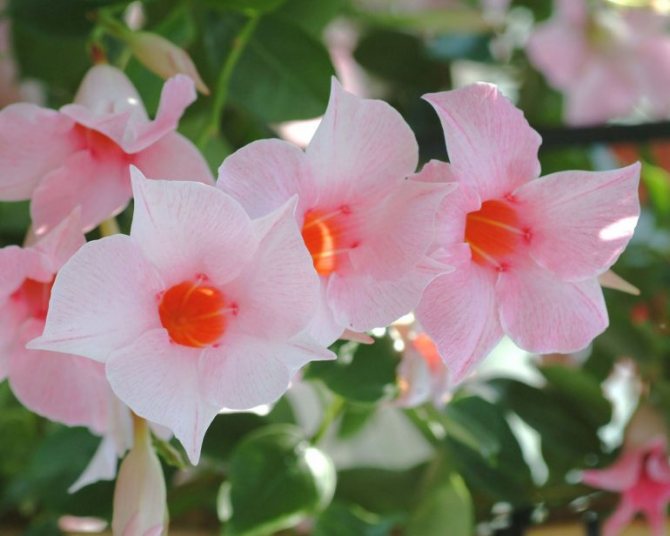

Classik Red - a plant variety that has rich red flowers with a yellow core.
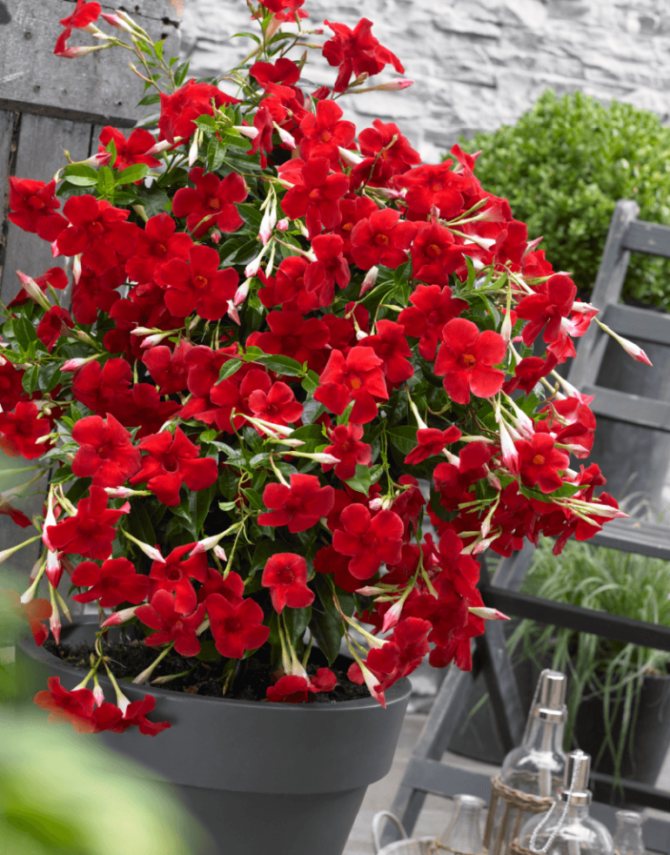

Cosmos pink - a sort of diplodenia with very large inflorescences, up to 12 cm in diameter for each flower.
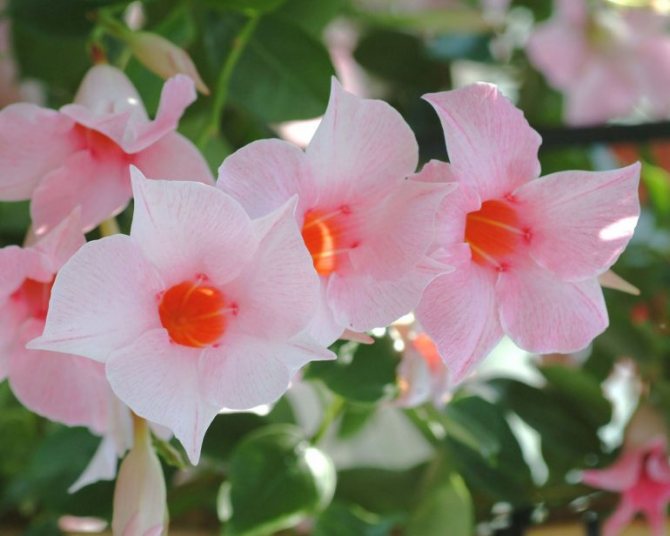

Red star - has flowers of a red-white hue with elongated petals.
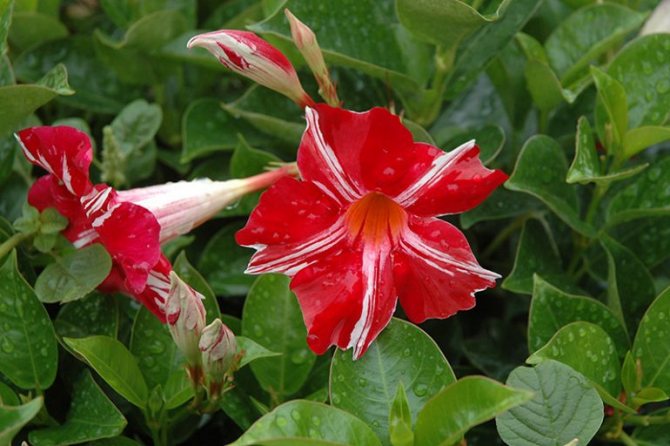

Transfer
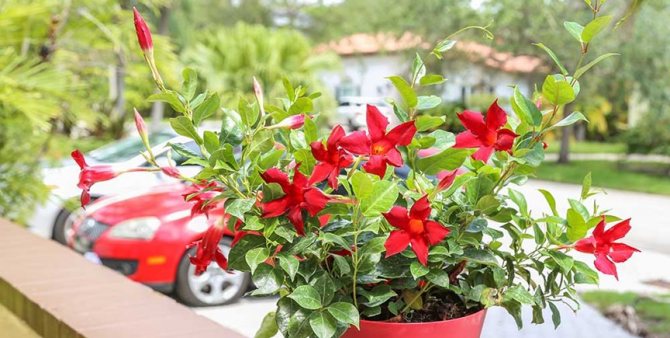

If you provide proper care for the diploidia, the vine will grow rapidly. And she will feel cramped in the old pot. Transplant young crops annually, adults as needed. You can understand that it is time to change the "house" for the plant by the roots protruding from the drainage hole. Start the event in mid-March or early April. At this time, the plant tolerates the procedure more easily.
Choose a ceramic pot for culture. Its volume should be one and a half times greater than that of the previous one.
Dipladenia prefers fertile, loose soil with a moderate acid reaction. For vines, a universal mixture designed for violets is suitable. To prepare the substrate yourself, mix in equal parts turf and leafy soil, peat, sand and humus. Be sure to disinfect the soil before planting. To do this, bake it in the oven or hold it over steam.
How to transplant a vine:
- Fill the pot 1/3 full with drainage. For these purposes, use expanded clay, red brick chips or pebbles.
- Powder the drain with a 2 cm layer of substrate.
- Remove the plant from the old pot without breaking the earth ball.
- Transplant the vine into a new container using the transshipment method, fill the voids with soil.
- Place a support next to the flower. A wooden or plastic sieve, a classic curly base or a trellis support will do. The height of the structure should be twice the height of the vine.
For the first 2-3 days after transplanting, do not water the flower. Then provide your diploma with the usual care.
Diplomas: leaving. Transplant, pruning, preparation for winter
Mandeville prefers loose, nutritious and moderately acidic soils. For an earthen mixture, sand mixed with peat, humus, turf and leafy soil in equal proportions is suitable. Sand can be replaced with fine perlite or expanded clay, which will increase the looseness of the soil, which will facilitate better oxygen transmission to the root system.
The transplant is carried out only if necessary, when the root system begins to need more space. If roots are visible in the drainage holes on the pot, then the capacity of the vine should be changed as soon as possible. When a vine reaches a mature age, it should not be transplanted. It is necessary to regularly replace the top layer with a new one.
Mandeville grows very quickly, so you can't do without regular pruning.Refusing to carry out such events, you can turn your apartment into an impenetrable jungle in a very short period of time. The buds are formed on the stems that appeared in the current year. Pruning is carried out after the growing season is over, in the fall. The stems of previous years without branching are shortened by 2/3, those that branch half below the branching.Thus, when the pruning is finished, a third of the shoot without branching should remain and a third after branching from the other. Autumn pruning is very important for wintering. If everything is done correctly, then the wintering will go well and the whole next waking season the plant will have active growth of young branches.
The plant begins to enter a state of vegetation dormancy by the end of autumn, with the arrival of the first March days, the plant wakes up. During all this time, the liana must be kept under conditions at a temperature that does not fall below +12 degrees and does not rise above +16 degrees. After autumn pruning, watering should be drastically reduced. Watering during this period is necessary only when the earthen mixture is completely dry and after that 3 more days will pass.
With the awakening of Mandeville, it must be transferred to the previous conditions of detention and irrigation must be resumed in volumes that are carried out in the summer, but this must be done gradually. At the same time, feeding begins.
Pruning
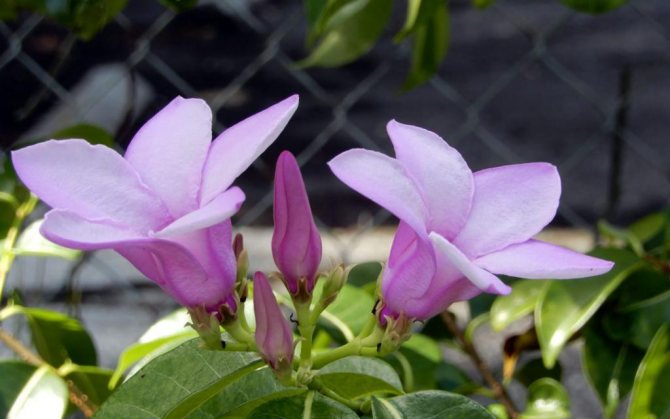

Liana develops quite quickly, and if you do not control its growth, then the diplodesy will quickly turn into thickets. In addition, plant buds are formed exclusively on the shoots of the current year. Therefore, liana needs regular pruning. Take the event every fall, at the end of the growing season. Shorten old unbranched lashes by two-thirds of the length, and branched ones by a third or half of their height.
Growing a plant
Reproduction of diplodenia is carried out in a vegetative way. In early spring, prepare apical cuttings 8-12 cm long. Each should have 3-4 leaves and a stem node. If there are side shoots on the cuttings, they must be removed. Immediately after pruning, the shoot is rooted in moist sandy-peat soil.
To avoid excessive drying out of the soil, the seedlings are covered with foil. Greenhouses need to be ventilated daily. Before rooting, the plants are kept in a bright place at a temperature of + 25 ° C. The roots appear quite quickly and after a month the seedlings can be transplanted into the ground. For the first transplant, use pots with a diameter of 12 cm.
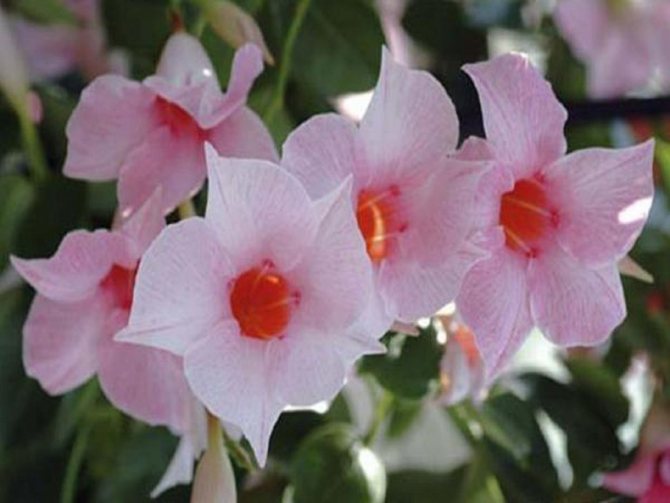

Growing a crop from seeds
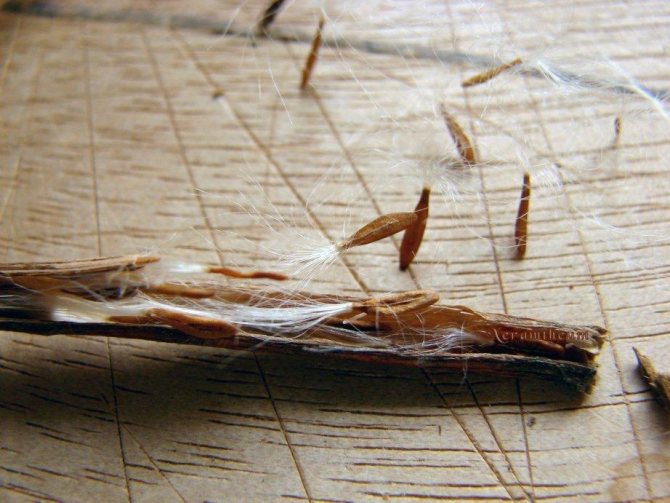

Adult specimens of vines are very expensive. And the seed breeding method of diplodenia will help significantly save money, because the price of seeds is quite affordable. In addition, it is not so difficult to grow a liana from them.
To grow seedlings, mix equal parts peat and sand. Be sure to disinfect the substrate before sowing. To do this, pour the mixture onto a baking sheet, moisten it and cover with a layer of foil. Calcine the soil for 40-60 minutes at 80 ° C.
Before sowing, soak the seeds of the plant for a day in any growth stimulator, for example, "Epine". How to germinate seeds:
- Fill containers or crates with disinfected soil.
- Moisten the substrate and distribute the seeds evenly over the surface. Cover the seeds to a depth of no more than 0.5 cm.
- Cover the planting with foil or glass and place it in a warm, bright room.
For the seeds to germinate, keep the temperature in the greenhouse at + 25 ... + 28 ° C. Ventilate the greenhouse daily and remove condensation from glass or film. Do not let the soil dry out and regularly spray the soil with warm water from a spray bottle.
The first shoots will hatch in 4-5 weeks. They will be weak, so do not remove the shelter and provide the seedlings with thorough care, protect the plants from direct sunlight, drafts and drying out of the substrate.
When 2 real leaves appear on the sprouts, start hardening. To do this, remove the film or glass, first for an hour, then for two, and gradually increase the time. Dive the hardened seedlings into individual pots with a diameter of 7 cm. Use the soil with the same composition as for adult vines. More details about the soil are written in the chapter "Transfer".
let's get acquainted
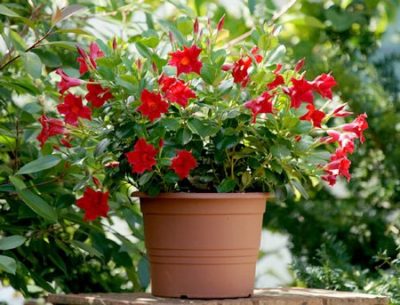

Dipladenia is an evergreen, fairly compact liana from the kutrovy family.
Her homeland is the tropical forests of South and Central America. Most often found in Brazil, Chile, Bolivia, Argentina, Mexico.
The tropical beauty has a double name. The word "diplodesia" comes from the Greek "diplos" - double and "aden" - glands... This means that the flower has two nectaries.
The name "Mandeville" was given in honor of Henry J. Mandeville, an English diplomat who worked in Argentina, a great lover of botany. There is also a whole list of popular names, such as Chilean jasmine, Bolivian rose, Brazilian balsam ...
Propagation of diplopia by cuttings
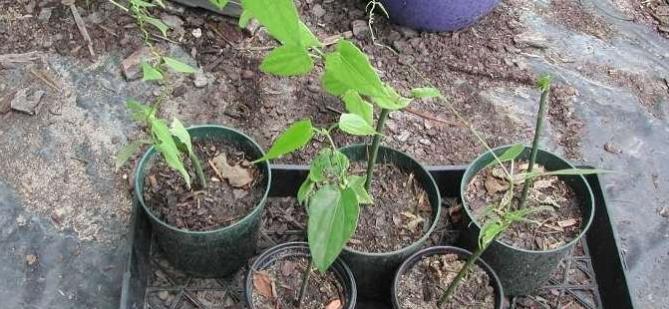

The event is held from April to the end of June. At this time, the plants take root better. For propagation of dipladenia, choose strong apical or stem shoots and cut their cuttings 8–10 cm long. Each branch should have two pairs of leaves. Cut at an oblique angle, just below the internode. Be sure to remove the bottom pair of leaves
Soak the cuttings for a day in Kornevin's solution. Prepare a peat-sand mixture for plants, which must be disinfected before planting. To do this, bake the substrate in the oven or hold it over steam. This will protect your plants from pathogenic microbes in the soil.
How to root cuttings:
- Fill crates, pots, or containers with decontaminated substrate.
- Moisten the soil well and bury the cuttings in it up to the first internode.
- Cover the shoots with a glass jar or cut-off plastic bottle. If you are growing cuttings in a large container, you can stretch a film over them. But make sure that the shelter does not touch the twigs.
- For the cuttings to take root, keep the temperature in the greenhouse at + 25… + 27 ° C. Ventilate the planting regularly and keep the soil from drying out. To do this, spray the soil with warm water from a spray bottle.
After 1-1.5 months, when the shoots take root and sprout new shoots, start hardening. Gradually remove the cover, accustoming crops to fresh air. Then, plant the mature and mature vines in individual pots filled with a suitable substrate. More information about the soil for diploidation can be found in the chapter "Transplantation".
Breeding methods
Seed method
Grown Mandeville is quite expensive and therefore not everyone can buy it in the nursery. But if the desire to grow a vine and decorate your home with it is strong and does not frighten the possible difficulties, then you can try to do it yourself with the help of seed material, which is presented in a large assortment in nurseries and specialized stores.
Sowing should be carried out in a container with drainage holes and filled with an earthen mixture. Recall that the plant loves soil that is loose, light and with an average level of acidity. After preparing the desired substrate, seed is sown on top. The containers should be kept in a well-lit and warm place at a temperature not lower than +22 and not higher than +28 degrees. Watering should be done regularly, keeping an eye on the constant moisture content of the soil and avoiding stagnation of water.
Before the first shoots appear, you need to be patient, since you can see them in 2 or even 4 months. All this time, it will be necessary to constantly keep the soil moist and prevent condensation from accumulating in the film. As soon as 2 leaves are formed, it will be necessary to dive through various small containers with drainage holes. Cups are fine.The soil mixture should be the same as that used for sowing. Once the plants are stretched out, they can be transplanted into their permanent location.
Propagation by cuttings
Reproduction using cuttings is carried out from mid-spring to July. To do this, it is necessary to cut off part of the upper newly appeared shoots in the spring, if the collection of cuttings is carried out in the summer, then lignified mature shoots are taken. It is important to remember that this plant is poisonous and if the leaves are damaged, you can harm yourself, therefore, when working, you must use rubber gloves and protect the skin and eyes from its juice.
For rooting, cuttings are sent in small containers with wet peat and sand mixed in equal proportions. You can also add dry sphagnum, one part will be enough.
When planting cuttings, it is necessary to make sure that they go deep into the soil to the first two leaves. After the containers are placed in greenhouse conditions, where the thermometer will not drop below +25 degrees. Water the cuttings from below, through the pallet. After a month, the cuttings form their own root system, after which they are transplanted to a permanent place. Rooting can be carried out in water and after they reach 2 centimeters in length, they can be planted in pots.
Having carried out all the procedures correctly, the roots of the cuttings will form quite easily. However, it happens that rooting does not occur, then you need to resort to the seed method.
Possible difficulties
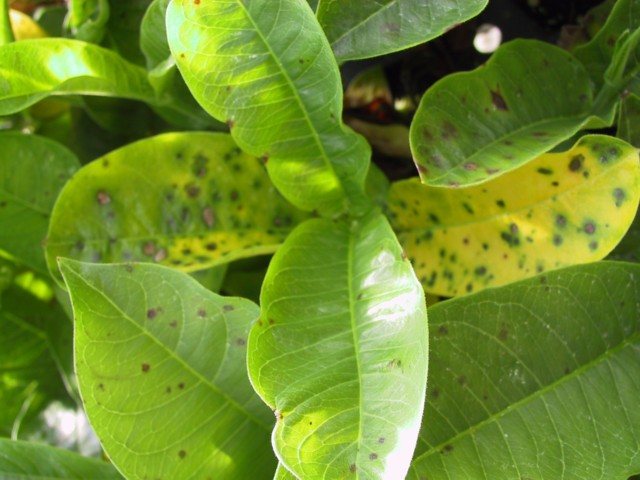

Diplomacy is a capricious culture, and with mistakes in care, the plant does not develop well. Florists often face such problems:
- Dipladenia does not bloom. Why is this happening? Most often, a lack of plant nutrition leads to the lack of buds. To remedy the situation, feed the crop regularly. Diplomacy does not bloom yet if it lacks light. Move the pot to a lighted windowsill or provide additional lighting for the vine with a photo lamp.
- Vine leaves turn yellow. If this phenomenon appears in the summer, then diplodesia suffers from low humidity. To remedy the situation, spray the leaf regularly and place the pot on a pallet of damp expanded clay or pebbles. If the leaves turn yellow in winter, then the plant is suffering from the cold. Move the pot to a warmer room and the vine will recover.
- The leaves of the culture are falling. This is how the plant reacts to insufficient or excessive watering. To remedy the situation, normalize irrigation. In addition, the vine sheds its leaves if it is cold. Therefore, keep the plant warm, and it will not have such problems.
Follow the growing guidelines and provide proper care for your diplodema flowers. And then there will be no problems with the vine.
How to root diplopia: the composition of the soil mixture for room vine
Look at the photo of a home flower of a diploma: in order to grow the same healthy specimen in your apartment, you need to take care of its soil.
- Firstly, the land must be fertile,
- Secondly, correspond to the previously described features of caring for this plant.
It means that regular watering also provides for the presence of appropriate soil: it is desirable that the composition of the soil mixture includes coarse-grained sand, which will allow water to pass through and provide free access of oxygen to the root system of the Mandeville.
In addition, experts advise using brick chips instead of ordinary earth (about a quarter of the total volume with particles that should not be larger than 5 mm). Such a clever move helps to reduce the frequency of watering tropical creepers.
To the question of how to successfully root diplodemy, experienced gardening masters advise to include peat and soil mixtures in the composition of the soil mixture: the fact is that many overseas plants prefer acidic soils.
Experts agree that a filler, which consists of old compost, coarse sand, cucumber soil - that is, a greenhouse - and, as already mentioned, peat, can be considered an ideal option for growing Mandeville in a pot.
Diseases and pests
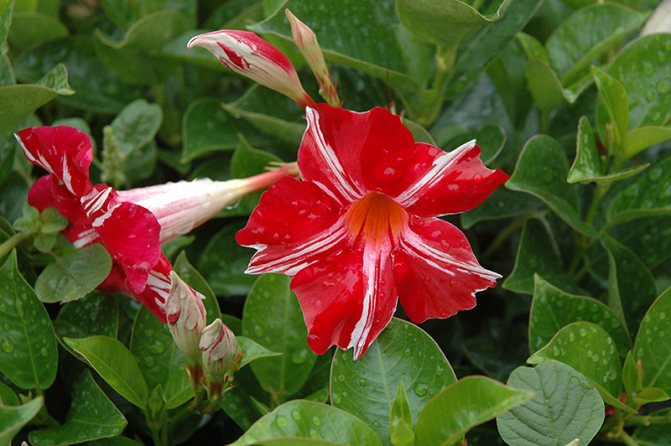

At home, diplodenia suffers from powdery mildew. This fungal disease is recognized by the untidy, whitish bloom that covers the aerial parts of the plant. For treatment, treat the flower with 1% colloidal sulfur solution. After a day, rinse the vine under running water. Repeat this procedure 2-3 times at weekly intervals.
Of insects, lianas are most often annoyed by such parasites:
- Spider mites. This pest is recognized by brown and black dots on the leaves and the thin, sticky web that covers the stems of the plant. To get rid of parasites, wipe the culture with soapy water. If this does not help, then treat the flower with acaricide. Be sure to increase the humidity in the room, because spider mites start up due to the dry air.
- Mealybugs. These small white bugs suck the juices out of the vine. Which leads to deformation of buds, wilting of leaves. You can see them with the naked eye, moreover, they leave white lumpy formations on the soil and plant stems. To get rid of parasites, pass the head of garlic through a press. Soak this mass for 4 hours in a glass of boiling water, then treat the vine with the resulting solution. From chemical preparations, the insecticide "Aktara" copes with mealybugs.
Remember that a well-groomed plant does not get sick, it is not attacked by pests. Therefore, create comfortable conditions for the vines and adhere to the growing rules. And then no parasites or microbes of the tropical beauty are afraid.
Features of transplantation and reproduction
Plant two or three plants in one container. So the vine looks much more spectacular. Culture does not stop growing upward. When creating a support, keep in mind that the diplodemy needs to be transplanted periodically. Young plants - once a year. And grown-ups - as needed. As the soil depletes over time, change the contents of the pot on average once every 3 years.
Nutrient soil is suitable for breeding. At the same time, the substrate must be perfectly water and air permeable. For looseness, you can add clean coarse river sand or perlite to the mixture. You can prepare the correct composition at home. Mix greenhouse soil, peat, perlite and rotted compost. All ingredients in equal amounts. Be sure to place a thick layer of drainage on the bottom of the container.
At home, liana successfully propagates by cuttings. The procedure is quite simple:
- It is best to do the breeding of a diploma in early spring. Then the liana will have time to get stronger before the arrival of the winter cold snap.
- Each part of the stem should have several leaves and one growing point. Plant the cuttings in a peat substrate. For greenhouse conditions, cover the top with a plastic bag or glass. Remove your cover daily for better air circulation.
- Rooting can be accelerated. To do this, arrange for heating from below with heating pads or water bottles. Use phytohormones.
- Keep the temperature above + 25 ° C. Then the roots will form after 6 weeks. Then small vines can be transplanted into small containers.
Features of seasonal care
In its natural environment, the diploidia grows intensively and blooms all year round. But at home it is difficult for her to provide year-round tropical conditions. Therefore, the plant needs to ensure proper wintering. During this period, the vine is in a state of relative rest. Its growth is slowing down. It is recommended to keep the plant at a temperature of + 12-15 degrees. Hypothermia of the soil must not be allowed. The flowerpot can be placed on a foam or wood stand. The regularity of watering should be reduced in the fall.The soil layer should dry out deeper between waterings, in winter it should be watered only after it has completely dried out.
Beautiful and slightly insidious Mandeville
Mandeville or diplomatic property can often be seen in Rio de Janeiro, Mexico City, Buenos Aires, or other cities in South America. The royal liana is not afraid of work; it, tirelessly of flowers and leaves, decorates the streets and squares. Florists-decorators are ready to give her freedom of action. And Mandevilla-Diplomatic property knows how to create a branch of the Garden of Eden on an unremarkable street. Its flexible stems twine around the supports, shiny leaves provide coolness, and magnificent flowers amaze with the perfection of shape, color and aroma. In their homeland, South America, diplomacy is very popular. The locals gave her many flattering nicknames. Brazilians call her balsam and jasmine, in Bolivia she is a rose. And the Mexicans called Mandeville the tree of love.
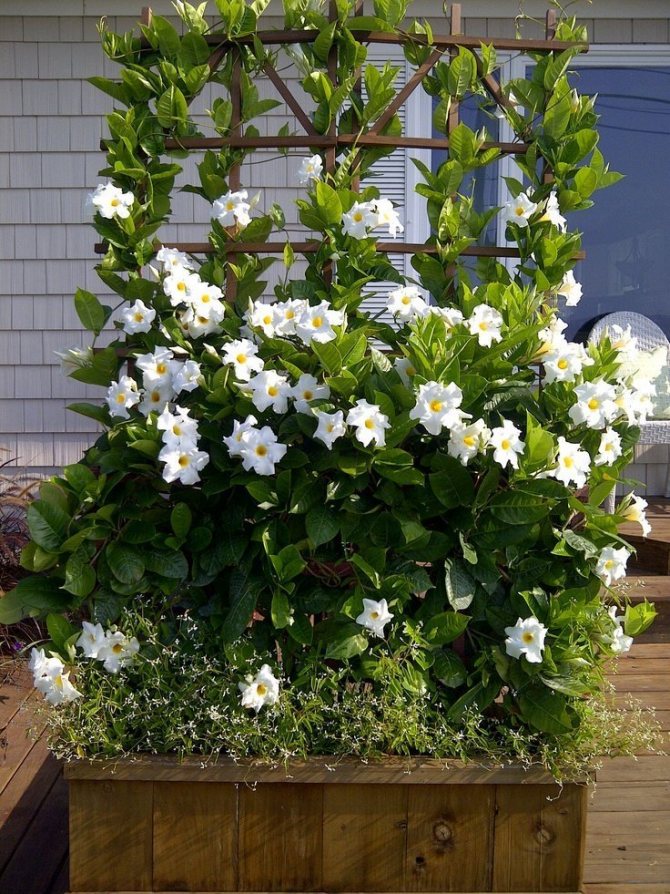

In its homeland, Mandeville is a favorite plant of flower growers.
There is a bit of confusion with the scientific name of the beautiful liana. In the 19th century, the newly discovered plant was named after the English flora lover Henry Mandeville, who also served as the British ambassador to Argentina. Later, similar vines were described, but they were given the name of diploding. For many years, botanists argued about whether it was one species or two. Friendship won. Mandeville and the diplomatic family were officially recognized as a single plant from the Kutrovy family. Now both names are in use. Actually, this is correct. Why should the royals, and this vine belongs to them, have less than two names?
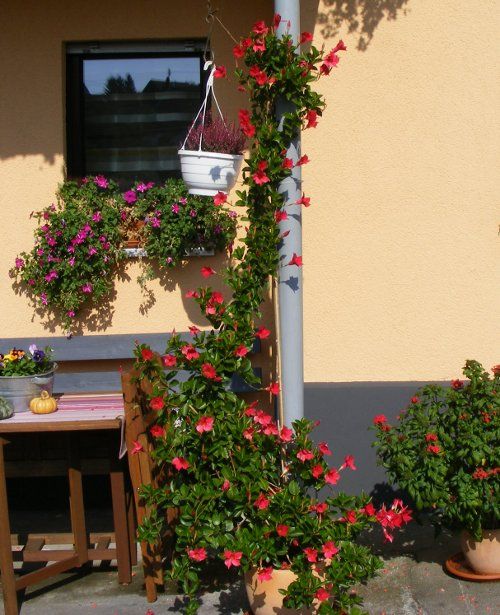

Diplomacy is able to bloom any corner
If you ask a botanist to tell you about this plant, he will say that mandevilla (dipladenia) is an evergreen shrub or semi-shrub with shoots of about 3-4 meters, with glossy, dark green leaves and funnel-like flowers. But such a description is too dry for a royal vine.
What is she - the queen of Mandeville-Diplomatic property? The Mexican tree of love is flexible, slender shoots, they gracefully and quickly wrap any support. Long branches are covered with shiny large leaves of an elongated oval shape. Large white, pink, purple, crimson or scarlet flowers cover the vine profusely and resemble stars. Five slightly curled petals are connected in the center, like an old gramophone. Diplomacy blooms magnificently 10 months a year. More than 50 flowers can open at once on the royal liana. And they live for about ten days.
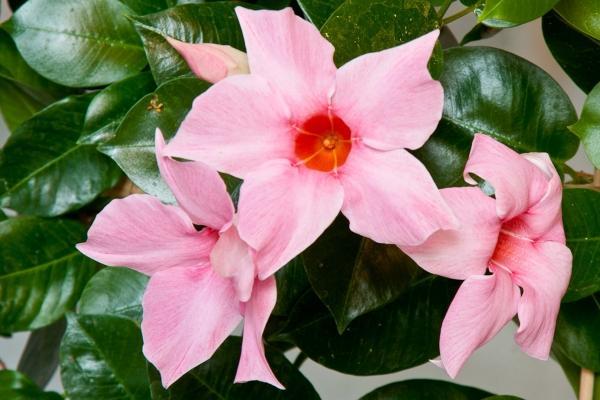

Delicate starry flowers of the royal creeper
As you already understood, the royal experience is guaranteed for the owner of the Mandeville. But there is one not the most pleasant circumstance. Like all royals, Mandeville is not only majestic, but also insidious. The juice of this plant contains poison. Therefore, when cutting a liana, it is imperative to wear protective gloves. You shouldn't decorate your home with Mandeville if you have small children or pets.
Well, for the rest - this plant deserves more popularity than it has already acquired. Mandeville grows very quickly, gives abundant decorative greenery and blooms beautifully for a long time. It can be grown as a bush, as a liana or as an ampel plant. All forms have their own charm.
Gallery: Diplomas in different forms
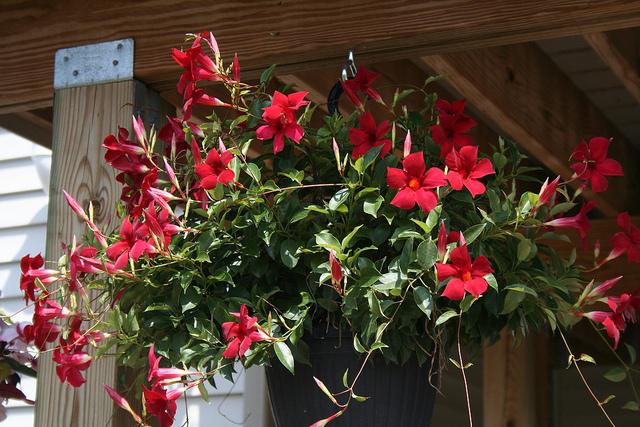

Ampel Mandeville
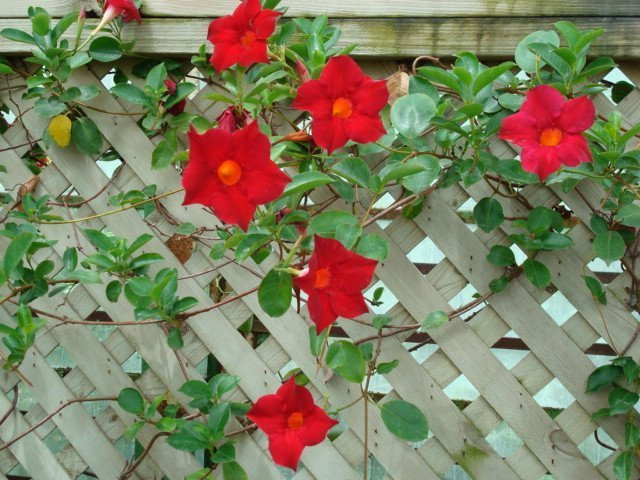

Liana mandevilla - decoration of the fence
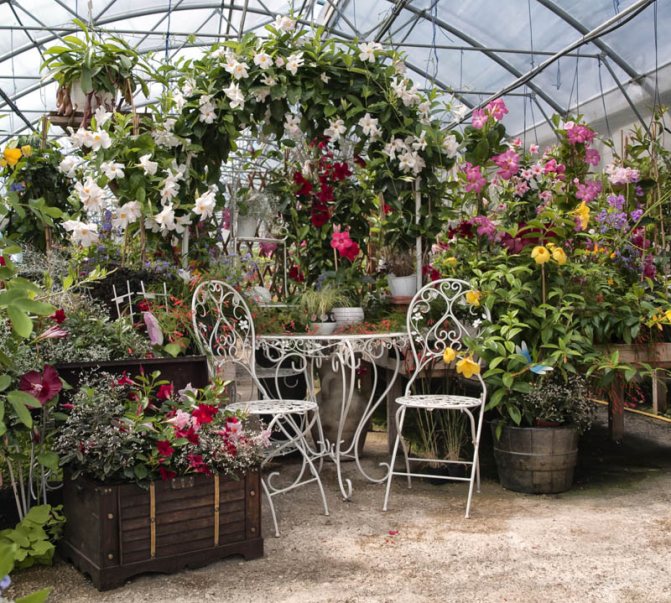

Winter garden full of vines
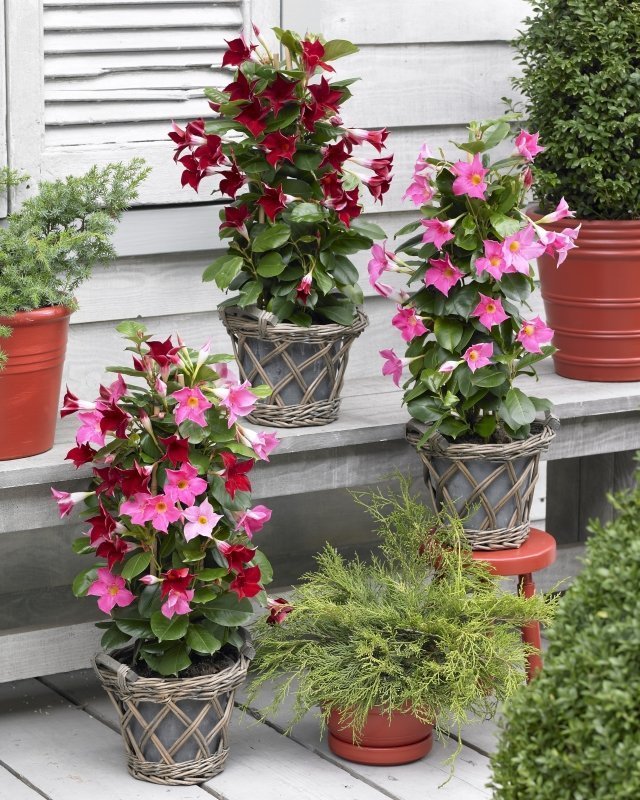

Bushes of multicolored dipladenia
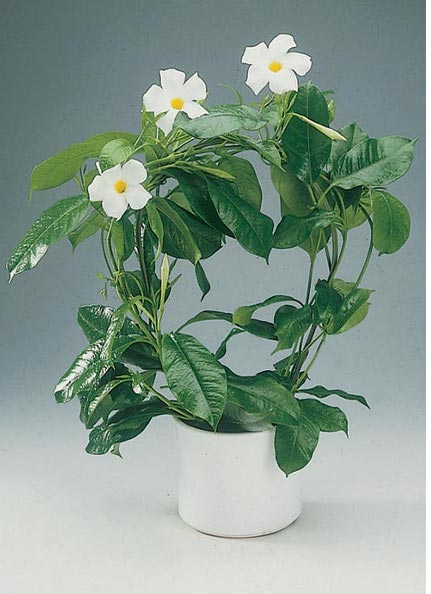

Diplomas on an arched support
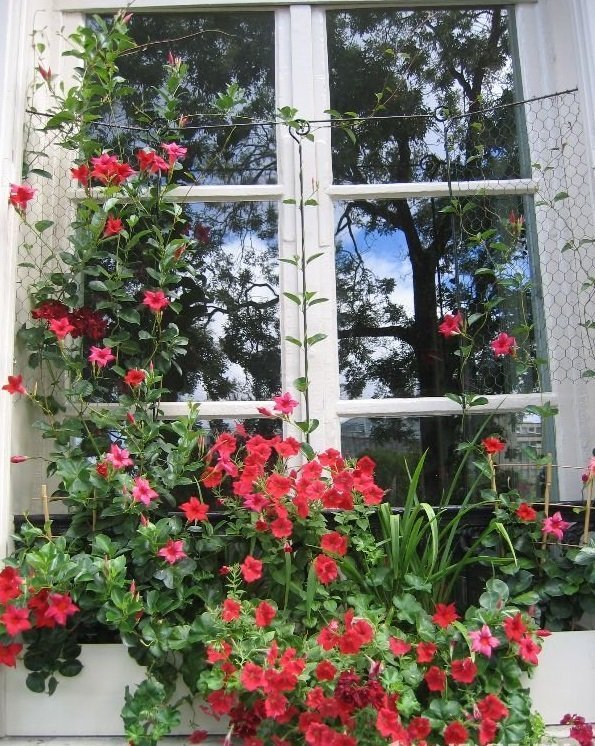

Liana beautifully decorates the window
Video: Mandeville is one of the best lianas.
Mandeville-dipladania - the queen of indoor lianas
Diplademia is also known as Mandeville. This happened because they were simultaneously and independently discovered by two different scientists. At first it was believed that these are two different plants, then they sorted out the confusion and combined them into one genus, but the names of this plant still have two.
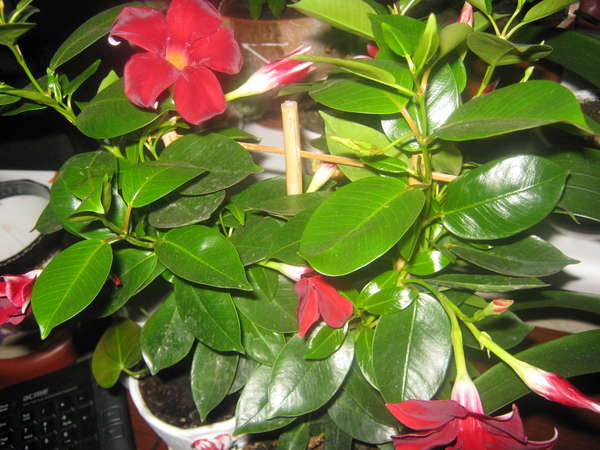

Diplomas at home
This ornamental plant belongs to the kutrovy family. Central and South America is considered his homeland. More than 40 species of Mandeville are known. Depending on the growing conditions, diploidia can grow into a flowering bush or become an ornamental branching vine.
The stems of flowering vines can grow up to 4 m. The leaves are dense, shiny and slightly elongated, they are dark green in color. Flowers can vary in color from white to red. They consist of five large petals arranged in a cone shape.
Up to fifty flowers can grow on one liana. The size of each of them is 5-12 cm. After the flower blooms, it lives for at least 14 days. Some varieties of dipladenia have a pleasant aroma.
It should be remembered that this plant, although very beautiful, is nevertheless poisonous. Juice is dangerous for him. Therefore, it should not be used in homes where pets or small children live.
Dipladenia loose
Used as indoor or garden flower. Flowers create a pleasant scent. The length of the stems reaches 4 m. The leaves of a greenish-grayish color are up to 15 cm long. The size of the flowers is 5 cm. They are white or cream in color.
Note! This variety is characterized by good frost resistance. When grown in the garden, it sheds leaves in cold weather. When used at home during the dormant period, this vine turns green.
Bolivian Diplomatic
This vine with a thin pink stem and small leaves (up to 4 cm long) has beautiful pink flowers. They grow in the form of inflorescences of 5-8 pieces.
Peculiarities of diploma
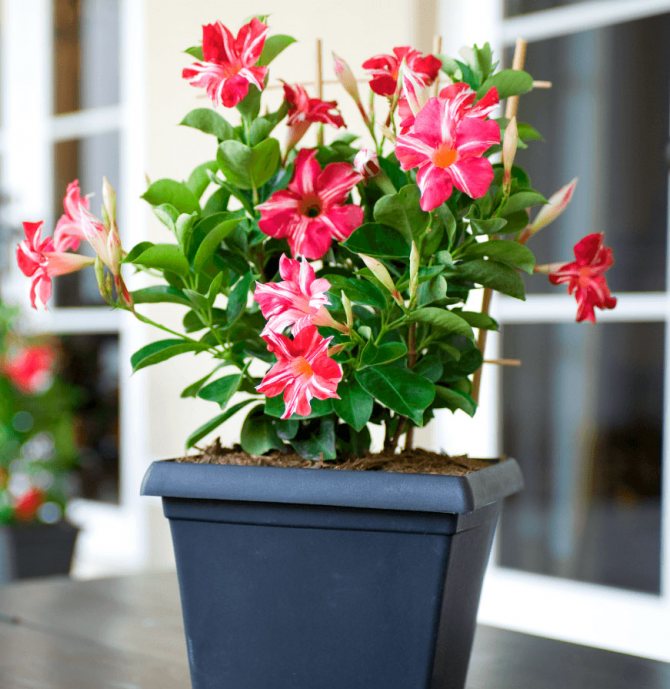

Mandeville is a lush, evergreen liana that grows rapidly. The stem is curly woody, it is decorated with oppositely located rich green leaf plates, they are glossy leathery to the touch of an oval shape. If you break a leaf, then milky juice, which is poisonous, will begin to ooze from it.
Under indoor conditions, diploidia is cultivated as a climbing plant or a compact bush. Fragrant funnel-shaped flowers consist of 5 petals, which can be pink, red, white or crimson. On an adult bush, up to 80 flowers can open at the same time, while they will delight with their beauty for more than a week.
How to plant and care for a indoor flower
The indoor diploma will grow beautiful and healthy, subject to all the rules of planting and care.
Landing time and technology
It is best to plant diplodesia in early spring. Place a drainage layer on the bottom of the pot. Pour 1/3 of the potting mix on top. Place a seedling with roots and an earthen lump in the center of the container. Then fill the remaining space with a nutrient substrate and compact.
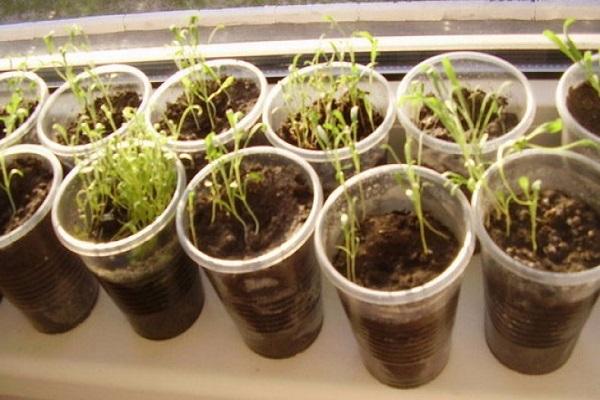

Watering
During the period of growth and flowering, this cultivated plant requires abundant watering - at least twice a week. The maximum frequency is three times to prevent excessive moisture, leading to decay of the rhizome.
The sure signal for the next watering is a slightly dried topsoil.
To water the plant, use soft water at room temperature. From time to time it is recommended to add citric acid in a small amount - 2-3 grains are enough for one liter of water.
Plant feeding
From March to October, twice a month, diplopia needs to be fed with universal liquid fertilizers that are suitable for most flowering cultivated plants. Nitrogen-containing products can only be used from March to April. After this period, they negatively affect the quality of flowering.
In winter, the plant does not need feeding. It resumes in the spring, at the end of the dormant period.


Pruning
For abundant flowering in the next season, the plant needs pruning. This procedure is carried out annually in October-November. With a sharply sharpened knife, two-thirds of the diplodenia shoot is cut off.
Tying to supports
A young plant needs support for the correct direction of growth. To tie up flexible shoots, you can use a curly plastic base or a trellis or trellis made of wood.
Diseases and pests: treatment and protection
Dipladenia is susceptible to root rot due to waterlogging of the soil. The development of the disease is evidenced by wilting of leaves and flowers. In this case, you need to carefully dig out the roots of the plant from the pot, rinse them, and then treat them with a fungicidal solution. Suitable preparations "Vitaros", "Baktofit", "Previkur Energy", which must be used strictly according to the instructions.
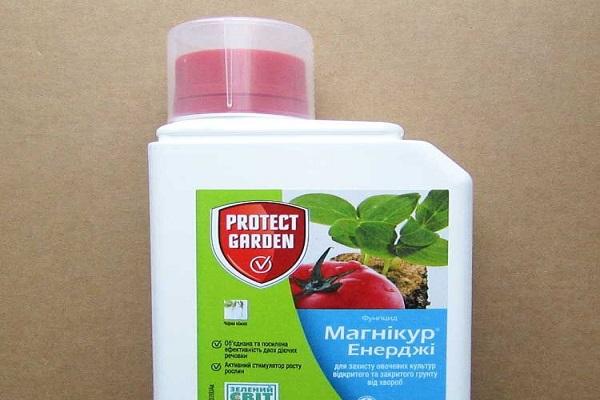

For preventive purposes, it is necessary to sterilize the soil before planting the plant, and also avoid excessive moisture.
The main pests of diplodenia, like many other plants, are root mealybugs, spider mites and whiteflies. Solutions of Aktara, Karbofos, Aktellik and other insecticides help to get rid of insects.
Demand for the variety Dipladenia
If you explore Mandeville for growing up in everyday circumstances, then there are a couple of types. More adapted diplomas include:
- The dipladenia is loose. It differs in the growth rate, the presence of elastic and thin processes, matte bright leaves. Flowers in the form of stars. Petals with wavy edges;
- Sandera is distinguished by rarely placed leaves on smooth processes. Leaves are strong, 5 cm long. A characteristic feature is a large, yellow throat, regardless of flowers;
- Splendens has radiant, heart-shaped leaves. The clusters of inflorescences have from five flowers. The flowers are white, and the throat is more catchy;
- The Bolivian variety is similar in appearance to Sandera, but the flowers are much smaller and do not shimmer. The leaves are sharp in comparison with other varieties;
- Dipladenia Excellent has red shoots, glossy leaves. The colorful flowers have clusters of eight flowers. Their length reaches 6 cm.
These tropical plants are preferably kept at home or in a greenhouse. Open soil is only suitable under the circumstance of a subtropical or tropical climate. The development of a small bush up to 45 cm in height is permissible when appropriate pruning is carried out. You need to take care of the Dipladenia plant carefully, since the juice is poisonous.
Care errors and their elimination
Problems in the cultivation of Dipladenia and their elimination:
| Problem | The reasons | Decision |
| Yellowing and falling leaves | The air is too hot | Observe the optimal temperature regime + 20-25 degrees in summer and 12-15 degrees in winter |
| Drooping leaves | Dry air, lack of fertilizers | Increase humidity by spraying the leaves, placing containers of water next to the flowerpot |
| The plant withers | Lack of watering | Water regularly as the soil dries |
| Dropping leaves and buds | Drafts, temperature changes, improper watering | Water the soil as needed, do not overmoisten it or dry it out |
| Pallor of leaves, decrease in flowers | Lack of lighting | Place the vine under a bright, diffused light |
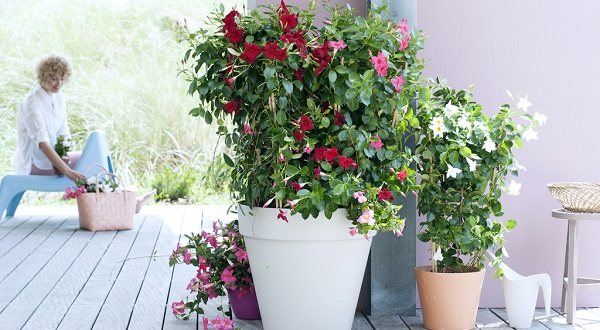

Variety of species
Mandeville, Brazilian balsam, Brazilian or Chilean jasmine, Bolivian rose, Mexican love tree - all these are the names that can be called diplomatic. Sometimes you can come across the opinion that Mandeville and diplomatic life are not the same thing, but this is not so. The plant got the double name due to the fact that the first studied varieties were called the flower dipladenia, and those found a little later and in another area - the flower of Mandeville. By comparing both of these varieties, botanists realized that they were one and the same plant. But both names remained for the same flower.
A beautiful evergreen plant with shiny leathery dark green foliage, shaped like pointed ovals. Luscious leaves frame the brightly colored, funnel-shaped flowers with five petals.They come in various shades in accordance with the species and variety.
The most common types of diploma are:
- Shiny dipladenia (dipladenia splendens) is an evergreen vine with up to four meters long shoots. It is often used as an ampelous flower. Flowers of a rich bright pink color, up to ten centimeters in diameter.
- Dipladenia sanderi (dipladenia sanderi) - liana, whose shoots grow up to three meters. The flowers are pink in color with a yellow gut. The most famous varieties of Sandera are Rubiniana and Dark.
- Excellent dipladenia / dipladenia praestans (in some sources dipladenia eximia) is another liana decorated with pink flowers, besides having red bracts.
The listed species are decorated with pink flowers, but diplodesy are also yellow, red and white. In addition to varieties with simple petals, there are also double dipledenias. Diplomas bloom profusely and for a long time, on well-groomed specimens it can sometimes bloom at once up to eighty flowers that do not fade for a little more than a week. In order for the flower to be healthy and feel good, it must be properly looked after.
Varieties
There are many different varieties of diploma. Lovers of this plant purchase a seed mix, which includes several varieties.
When does diplophenia bloom? With proper care, the plant can delight with its flowering all year round.
The most popular varieties among florists:
- Excellent. The color of the buds is pink.
- Sander. The plant grows up to 3 meters in length, the main color of the buds is red, the core of the flowers is yellow.
- Ed. A fast-growing liana with red flowers.
- Diamantina wives white. Vines have shortened stems, which makes it easier to form a bush. This variety is well suited for the home. The color of the buds is white.
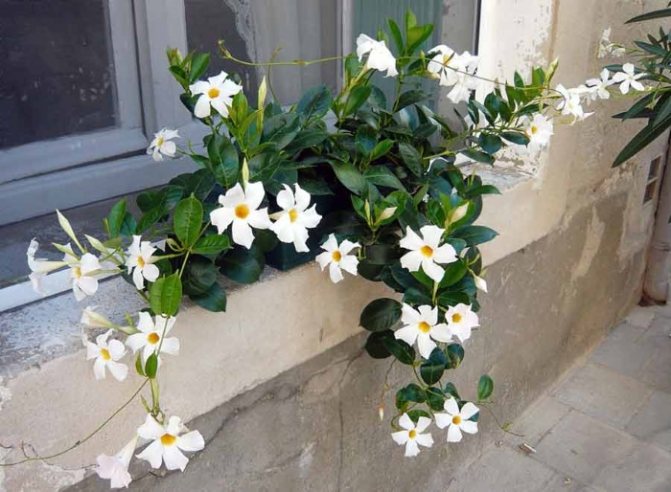

A brief description of the varieties will help to collect a beautiful composition in your home or on the site. Experts assure that white diploma looks best in combination with any bright shade.
Planting in pots
Fuchsia cultivation and care at home
This ampelous plant will look beautiful if grown in a hanging planter. It must be transplanted at least once every two years.
If in the spring you notice that the roots pass through the drainage holes, then it's time to move the flower to a new planter. If the roots are not sticking out, then a transplant this year is not necessary.
For planting, you need to prepare a suitable potting soil. It should consist of humus, leafy earth, sand, peat and turf. The best time to plant a Diploma is spring.
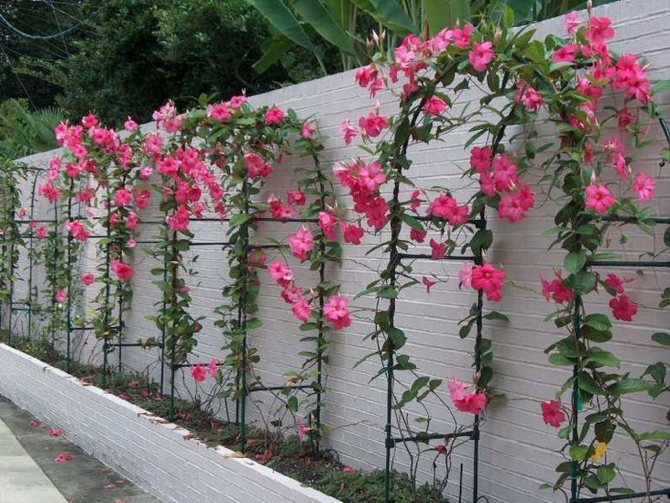

Diplomas in landscape design
Common types
The most common types of diploma:
- Sander - semi-peeling evergreen shrub, reaching a height of 3 m. Dark green shiny leaves of dense structure are formed on the shoots. The flowers are pink with a yellow throat.
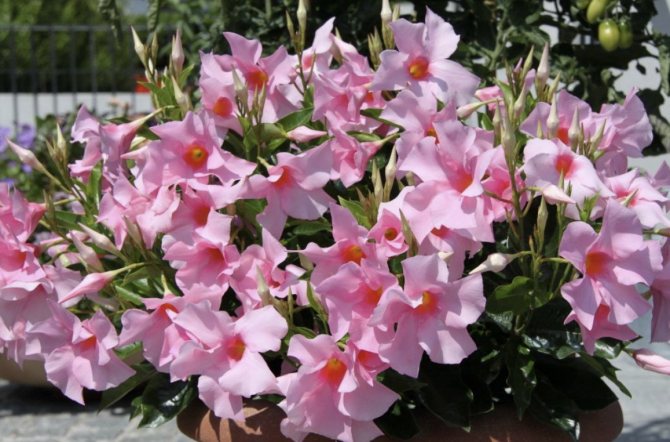

- Mandeville loose - a deciduous representative, reaching 4 m in height. On the warty shoots of the flower, ovoid green leaves are located oppositely. During the flowering period, forms bouquets of 5-10 flowers. The color of the flowers is white. The petals are corrugated along the edges.
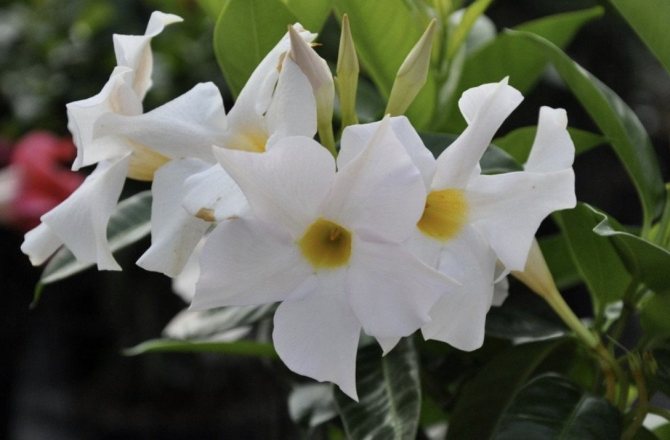

- Diplomas yellow - a beautifully blooming liana-like representative, characterized by unpretentious care. The leaf plates are shiny, green, with a rigid structure. Yellow flowers form clusters of 3-5 pieces.
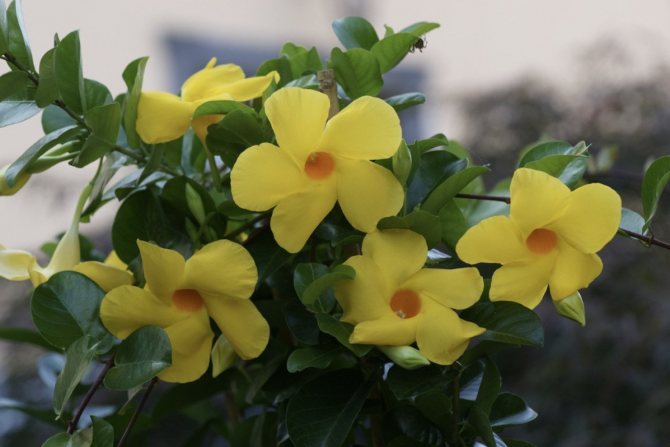

- Mandeville is superb - an evergreen plant, reaching a height of 3 m. Leaves are dense, green. Flowers of red color are collected in bouquets of 5-7 pieces.
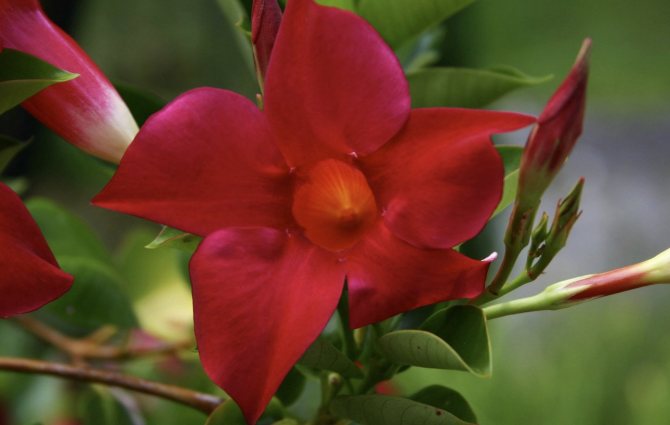

Brief description of cultivation
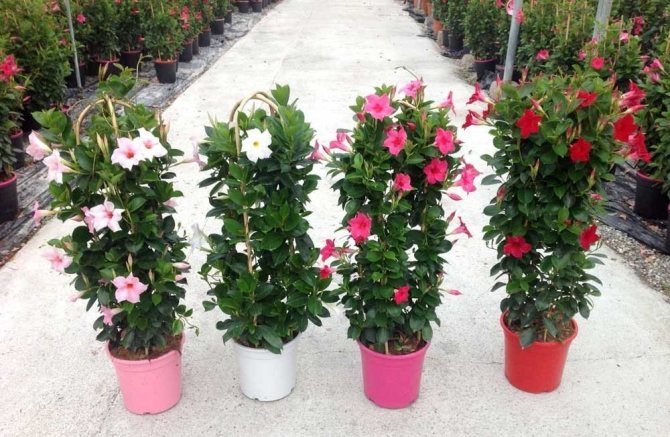

- Bloom... Lush and long lasting (from the last days of March to November).
- Illumination... Needs bright but diffused light. Recommended to be placed on a window sill of either western or eastern orientation.
- Temperature regime... During the growing season - from 18 to 26 degrees, and during the rest period - from 12 to 15 degrees.
- Watering... It should be abundant twice or thrice a week. The soil mixture in the pot is moistened only after its surface dries out to a depth of 10 to 15 mm. On very hot days, the bushes are sometimes watered twice a day. Beginning in September, watering is gradually reduced.
- Air humidity... Should be elevated. To do this, the flower is kept in a special glass case, or the pot with the plant is placed on a pallet filled with wet pebbles.
- Fertilizers... Top dressing begins in March, from this time liquid nitrogen fertilizers are applied to the substrate 1 time in 7 days. However, with the beginning of the formation of buds, the flower should be fed with a potassium-phosphorus complex fertilizer, which is applied systematically once a week until August.
- Pruning... It is carried out systematically in the autumn, immediately after the end of the growing season.
- Transfer... If necessary, after the root system of the bush becomes very cramped in the flower pot. Adult shrubs are not transplanted; instead, the top layer of potting soil is regularly replaced.
- Reproduction... By cuttings and seed method.
- Harmful insects... Whiteflies, mealybugs and spider mites.
- Diseases... Powdery mildew.
Features of care during the rest period
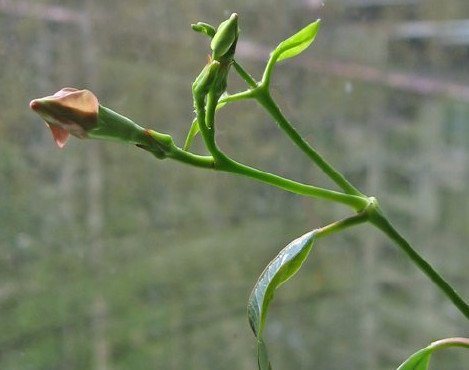

In winter, diplodesy often suspend the growth of shoots, reducing the amount of watering. As a result, with insufficient daylight hours, the plant hibernates until spring. It is preliminarily cut and sent to a cool room, where the temperature regime is not lower than 15 degrees. It is strongly not recommended to put a container with an earthen tuber on a windowsill in a cold room or on a balcony. Overcooled soil will inevitably lead to the death of the roots.
Water the Mandeville at rest as the potted soil dries up. Spraying and feeding is completely stopped until full awakening.
Problems when growing a Mandeville or a Diploma:
- Yellowing of foliage in summer occurs due to too dry indoor air, in winter if the liana is cold;
- Leaves wither, turn pale and crumble if the air in the room is too dry;
- Slow growth indicates insufficient fertilization of the plant;
- Falling leaves occurs due to irregular, insufficient, excessive watering, it can also occur when the room temperature is too low;
- Leaf curling occurs in dry air.
Views: 208
Reproduction
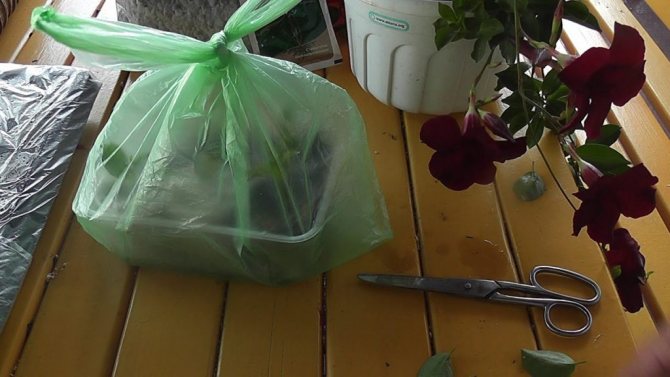

Cutting Dipladenia
For reproduction of diplodemy, the seed method, cuttings and rooting of antennae are used. The easiest way is propagated by cuttings.
back to menu ↑
See also: Carnation - a perennial garden plant: description, types and varieties, methods of growing and reproduction, planting and care in the open field (60+ Photos & Videos) + Reviews
Seed propagation
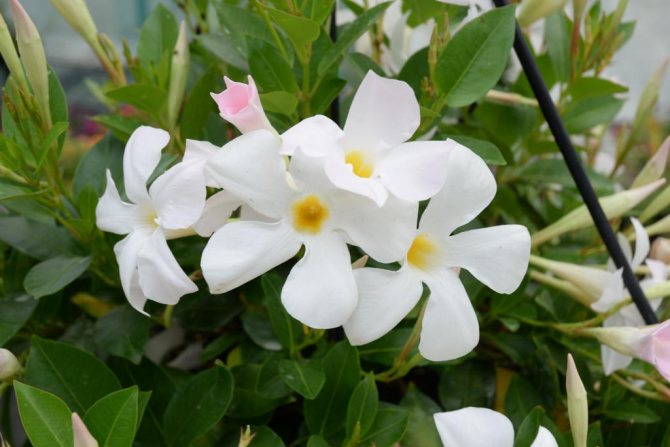

A beauty grown from seed
In specialized stores you can find seeds of dipladenia. Good germination is observed at temperatures from +23 ° C. Sowing seeds should be done in light, air-permeable fertile soil with a slightly acidic reaction, mixed with perlite. Moisten the potting mix with a fine spray gun to avoid swamps. In too wet soil, the seeds will die.
During germination, the container must be covered with foil. Some growers cover with glass.
Many growers add moss to the soil to reduce the frequency of watering. But the introduction of sphagnum into the soil mixture should be carried out wisely, since excessive application of moss can lead to rotting of plants.
The first shoots will appear after 2-3 months. At this time, it is necessary to ventilate the plantings and make sure that the earth does not acidify and mold does not form on the surface of the soil.
back to menu ↑
See also: What to do if plastic windows in a house or apartment sweat? Reasons for the appearance of condensation. Ways to solve this problem + Reviews
Reproduction by antennae
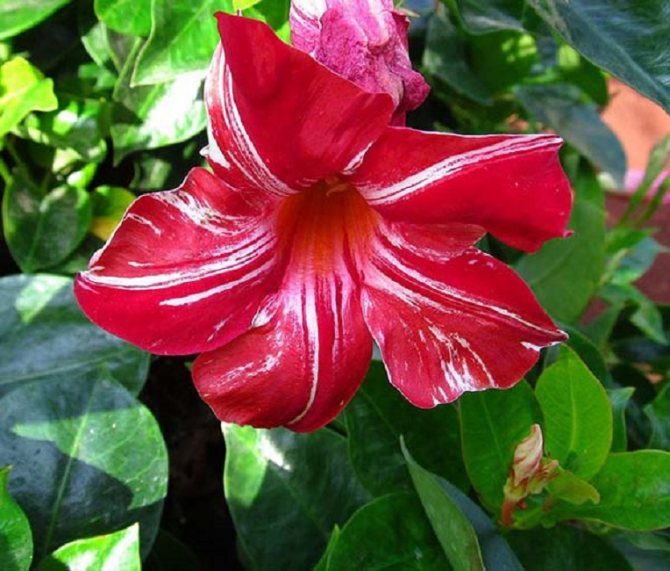

Varietal diploma with gorgeous flowers
Swirling formations can be seen at the top of the shoots. These are antennae. In other words, the apical unripe cuttings.
To get a complete plant, you will need to bend the unbranched shoots to the fork to the ground, pin the antennae.
When the roots appear the plant is planted in a new substrate.
back to menu ↑
See also: How to properly preserve apples for the winter at home: exploring the subtleties and possibilities |
Cuttings


Summer move to the garden
Cuttings are cut mainly in spring and summer. For this, a healthy dipladenia bush is chosen. You need to cut the cuttings from the mother bush, from young, not yet lignified shoots.
During cuttings, it is necessary to work with gloves, since all parts of the plant secrete a poisonous milky sap. If the juice does get on the mucous membranes or skin, it is recommended to immediately rinse your face or hands.
Each cut cut should have 2 pairs of leaves. You can root in disposable cups, on the bottom of which drainage must be laid. At the bottom, you can pour crumbs, cover the bottom with pebbles, expanded clay. Roots appear quickly if the room temperature is + 25 ° C. After all, it is necessary to place the cups with cuttings in a mini-greenhouse to stimulate the formation of roots. It is recommended to ventilate the greenhouse daily to remove condensation.
Water as needed. Waterlogging can lead to the death of the planting material. After a month, you can see the first roots. Now you need to transplant the small plants to a permanent location.
When propagated by stem cuttings taken from varietal diplods with double flowers, some of them do not want to form roots. In this case, rooting with antennae is recommended, since during seed reproduction, children do not repeat maternal signs.
back to menu ↑
See also: Primrose: description, varieties for home cultivation from seeds, compliance with the rules of cultivation and care (50+ Photos & Videos) + Reviews
Popular varieties
In total, there are more than four dozen varieties and varieties of this tropical plant in nature. You should familiarize yourself with the most popular ones.
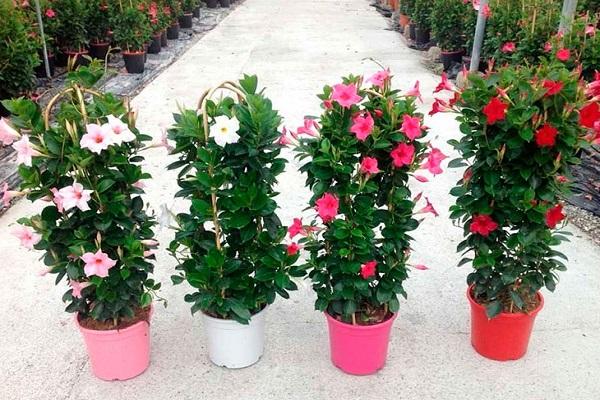

Loose
A distinctive feature of friable dipladenia is the presence of numerous short processes on the sides of the trunk. The leaves are medium in size, have a grayish-green tint. Loose apical inflorescences consist of snow-white or pale cream flowers with pointed petals. The plant is highly resistant to temperature extremes and is capable of rapidly growing green mass.
Sander
The average plant height is three meters. Each inflorescence contains 3-5 flowers of a rich yellow-pink color. The leaves are small and pointed.
Excellent
This is the most graceful and delicate variety of dipladenia. The thin stem of the liana with slight pubescence has a pink color. Collected in a brush, flowers of an expressive pink shade contrast effectively with medium-sized green leaves.
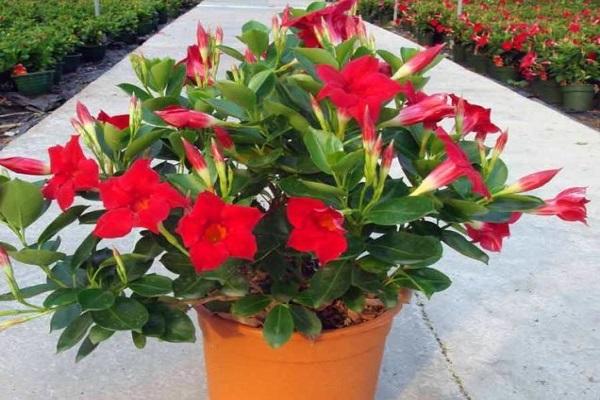

Bolivian
A variety of creepers for indoor cultivation. There is a slight hairiness on the stem. Dark green leaves of miniature size with a shiny attractive surface. Fragrant white flowers are collected in a cluster.
Shiny
Plant with tall shoots and large oval, glossy leaves. The color of the flowers is very expressive - deep pink with a contrasting crimson core.
Red
A characteristic feature of this variety is the rich red color of the inflorescences against the background of dark green foliage. The plant is large, hardy and resistant to temperature extremes.
